Archive for the ‘Listening Post’ Category
Saturday, May 28th, 2011
Valuable fringe bushland of the Central Blue Mountains (BM) is steadily disappearing as a consequence of Blue Mountains (city) Council-approved housing development integrated with the associated hazard reduction burning that it invites.
Blue Mountains Council has become culturally conditioned to automatically squirm and acquiesce when any threat of a State Environmental Court appeal process that may be instigated to dare challenge Blue Mountains Council, despite a fair and rigorous environmental assessment and ruling. Local political pressure is such that now Blue Mountains Council staff are encouraged to give up and bend over, as if so urbane as to be beholden to developer intimidation. Yet for years such has become Blue Mountains Council’s urbane squeamish mindset, as if the staff and management came from overdeveloped Western Sydney (which most of them they have).
There are morally corrupt politics controlling land use development in the Blue Mountains ~ many are receiving a cut of perceived cheap, yet increasingly scarce, bushland habitat.
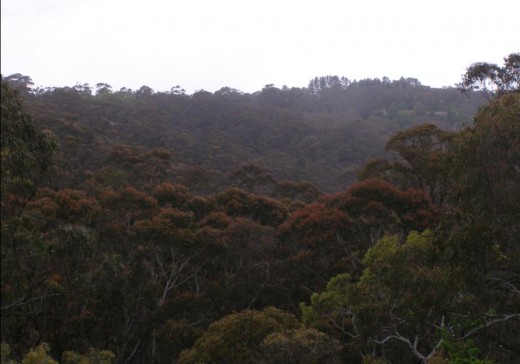 Thick natural bushland habitat just west of Katoomba
Central Blue Mountains Region.
New South Wales, eastern Australia. Thick natural bushland habitat just west of Katoomba
Central Blue Mountains Region.
New South Wales, eastern Australia.
.
.
Case in point:
.
Not so long ago, Blue Mountains Council approved this cypress pine cottage be built in/abutting thick timbered bushland on a west facing slope downwind of the prevaling westerly winds.
Bushfire risk mapping rated the site as ‘extreme’ bushfire risk, yet the cypress pine cottage got built. The builder/developer has long since profited and so moved on, leaving behind a bushfire vulnerable cottage on a site that should never have been built on in the first place.
But try telling a pro-development council that a property owner can’t develop his/her land!
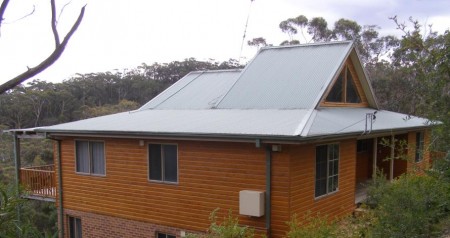 The cypress pine cottage, 2008
. The cypress pine cottage, 2008
.
The site was purchased in/abutting dense wooded bushland, which was slashed and bulldozed. Down from the house, around a dozen mature native trees were chainsawed to provide for escarpment views to the west.
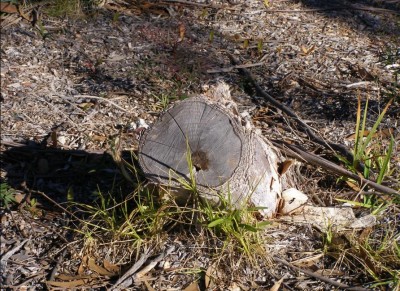 One of the chainsawed native trees
. One of the chainsawed native trees
.
The property has since been sold. Yet, the issue of a cypress clad cottage being approved in extreme fire risk bushland was raised with Blue Mountains Council’s senior development officer, Lee Morgan, on 25-Feb-2009 (Council ref. Customer Service Request #106889). But there was no response.
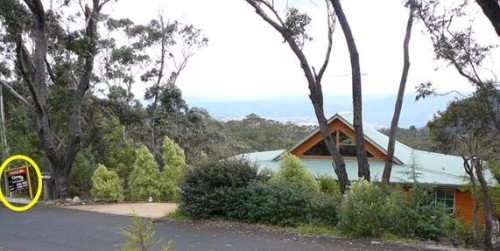 The cottage was sold in 2008…with views
…less the dozen chainsawed Eucalypts to make way for the views. The cottage was sold in 2008…with views
…less the dozen chainsawed Eucalypts to make way for the views.
.
It is typical of Blue Mountains Council’s planning approvals that they encourage development encroachment on the fringe bushland which separates the Blue Mountains National Park from the townships of the Central Blue Mountains.
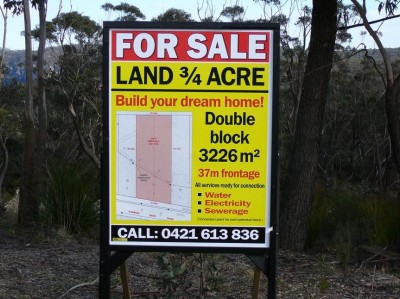
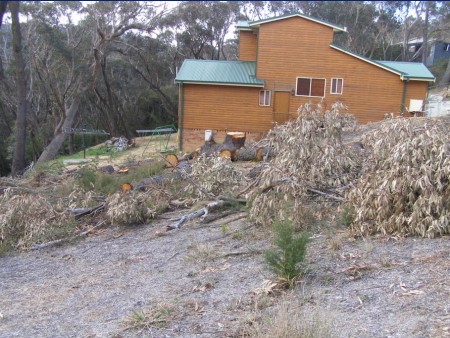 A nearby cottage of remarkably similar cypress pine cladding
has surrounding trees chainsawed and the vegetation slashed to bare earth. A nearby cottage of remarkably similar cypress pine cladding
has surrounding trees chainsawed and the vegetation slashed to bare earth.
.
.
Then comes the ‘hazard’ reduction
.
Housing development encroachment is being wedged deeper into fringe bushland, closer to the Blue Mountains National Park, many seeking the profit that escarpment views bring. The sites are indefensible against bushfire. Many are zoned extreme bushfire risk, yet these bush houses received Council building approval.
The Rural Fire Service (RFS) calls for hazard reduction because, with just its truck resources, it would not have access to defend these houses in the event of a serious bushfire. Co-incidentally, the property owners (developers) now cry for RFS hazard reduction to protect their ‘assets’ from the risk of bushfire. Co-incidentally, many property owners (developers) in the vicinity who have these new bush houses do the same.
Of course, to the fire-lighting cult, this is music to their ears and so the Rural Fire Service in cohorts with Blue Mountains Council rustled up a hazard reduction certificate. In September 2008, Blue Mountains Council’s Bushfire Technical Officer, Peter Belshaw, issued a Hazard Reduction Certificate for over 11 hectares of bushland and escarpment heath across Bonnie Doon Reserve to be burnt under a ‘hazard’ reduction programme. Click on image below for details.
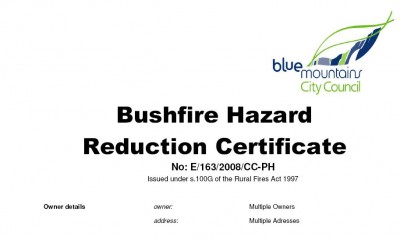 Click image to open PDF document Click image to open PDF document
.
Earlier that year in mid February (2008), some seven months prior, slashing of heathland and a watercourse had been carried out by a Rural Fire Service contractor in preparation for the hazard reduction burning ~ the fire-lighters just couldn’t wait.
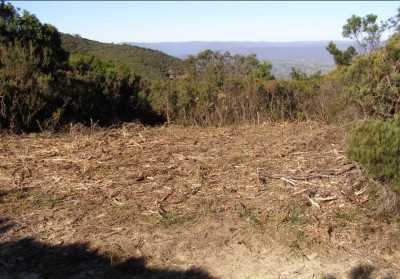 Blue Mountains escarpment is slashed by the RFS, a kilometre west of the cottage site. Blue Mountains escarpment is slashed by the RFS, a kilometre west of the cottage site.
.
.
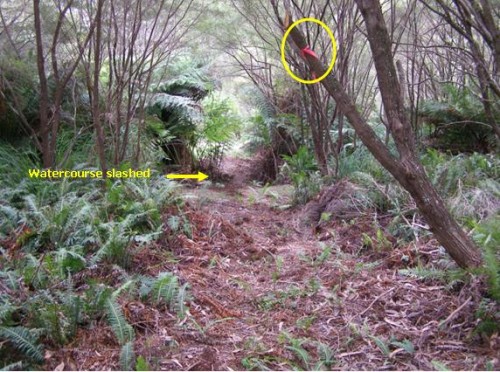 The RFS contractor slashed a trail for over 700m through heathland and through a riparian zone,
even before the Hazard Reduction Certificate was issued.
.
The RFS contractor slashed a trail for over 700m through heathland and through a riparian zone,
even before the Hazard Reduction Certificate was issued.
.
Then comes the intense HR burning:
.
Three years hence, mid afternoon on Friday 11th February 2011, smoke can be smelt and seen rising to the west on the horizon near Bonnie Doon Reserve. A call to emergency ‘000’ confirms that it is not a bushfire, but that official hazard reduction operations are underway. It is still well within the bushfire risk season.
.
Bonnie Doon Reserve is a natural wild area of about 22 hectares that includes a mix of bushland, heathland and upland swamp situated on the Blue Mountains escarpment at the western fringe of the township of Katoomba. It lies above Bonnie Doon Falls. The area is zoned ‘community land’ and ‘environmental protection’ and comes under the control and custodianship of the Blue Mountains Council. Bonnie Doon Reserve has a history of volunteer bushcare to conserve the still wild Blue Mountains escarpment habitat. The reserve is immediately upstream of the endangered Dwarf Mountain Pine (Microstrobos fitzgeraldii) and Leionema lachnaeoides (yellow flowering shrub) found almost nowhere else on the planet. The habitat conservation of both species, particularly the exclusion of fire are considered critical to their survival as a species.
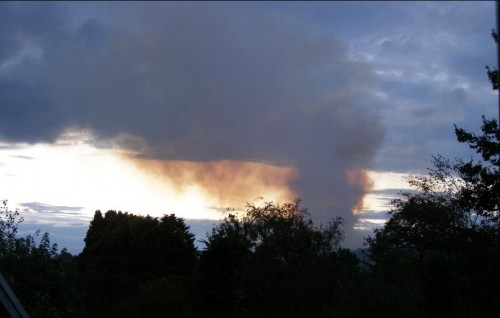 The ‘hazard’ reduction (HR) burning commences The ‘hazard’ reduction (HR) burning commences
.
From a distance of about two kilometres, I can see the smoke billowing strongly and its lasts for over two hours. The direction of the smoke places it around Bonnie Doon Reserve. The strength and density of the smoke indicates that it is more than light burning of ground cover. It is an intense but localised fire.
.
The aftermath of the burning:
.
We have our suspicions, but with other commitments we can’t get around there for some time to investigate the location affected to determine the scale and severity of the burning. In fact it isn’t until nearly three months later on Sunday 1st May 2011, that we inspect the burnt site. The fire was localised.
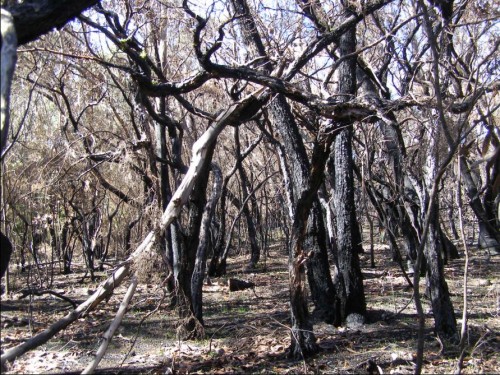 The aftermath
Three months on, evidence of more than just ground-cover has been burnt.
Deliberate intense burning has been allowed to penetrate deep into mature Eucalypts The aftermath
Three months on, evidence of more than just ground-cover has been burnt.
Deliberate intense burning has been allowed to penetrate deep into mature Eucalypts
.
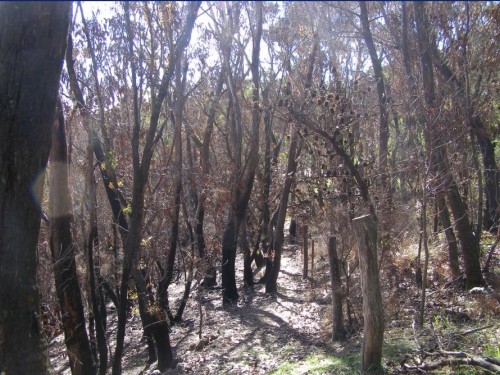
.
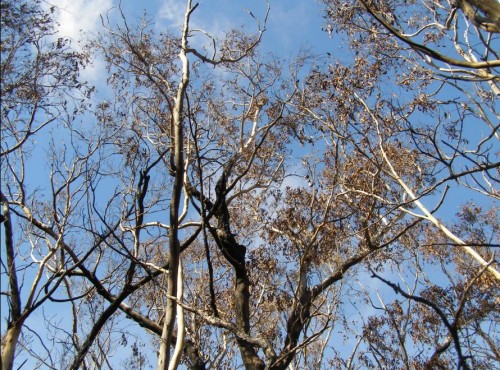 The fire was so intense that the flames reached into the tree canopy.
It must have been a blaze and half for RFS fire-lighters. The fire was so intense that the flames reached into the tree canopy.
It must have been a blaze and half for RFS fire-lighters.
.
.
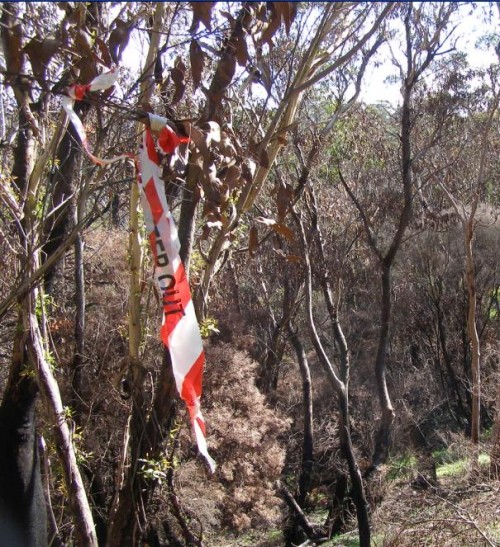 RFS telltale
. RFS telltale
.
The fire was indeed localised. It is very clear, still three months on, that this ‘hazard’ reduction burn had specifically targeted the native bushland surrounding the cypress cottage – an area of perhaps two hectares.
Consequence:
So not only has the developer of the cottage site completely destroyed the bushland on the site, but he has succeeded in having an additional two hectares burnt in the process all associated with the one cottage. Council’s initial approval of the cottage construction has directly led to the destruction of two hectares of what began as intact native bushland. The developer has profited from the bush, but in the process the ecological cost has been ignored ~ it is a perpetuation of a 19th and 20th Century single bottom line exploitation of the natural environment. It is happening across the Blue Mountains and being encouraged by Blue Mountains Council rules, practices and attitudes.
.
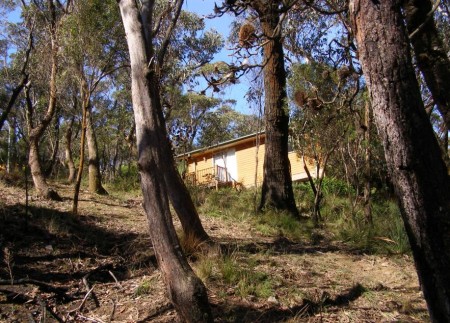 The cottage relative to the HR burn (aftermath) The cottage relative to the HR burn (aftermath)
.
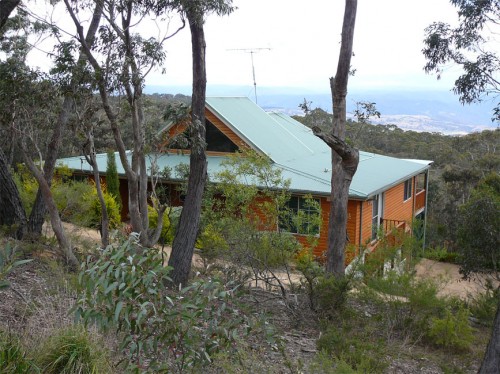
The cottage now with great views, plus an extra 2 hectares of cleared bush done cheap
Blue Mountains (city) Council making bushland-fringe development cheap
.
The ‘hazard’ reduction certificate process has become an insidious part of the development process across the Blue Mountains. The catalyst that is Council’s lax bushland protection zoning, is facilitating fringe deforestation. The combination of Council’s housing approvals on bush blocks with its ‘hazard’ reduction approvals have become a self-perpetuating twin mechanism for incremental encroachment into Blue Mountains fringe bushland, and it shows no sign of stopping.
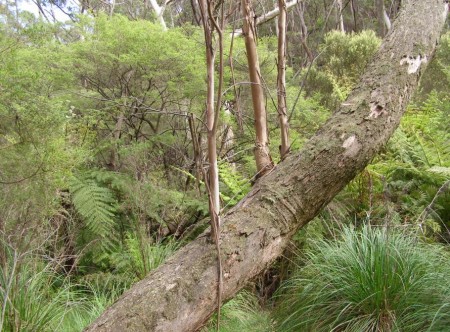 Bushland habitat at Bonnie Doon at risk of further burning Bushland habitat at Bonnie Doon at risk of further burning
.
Hazard reduction has become a cosy win-win-win-win outcome for all collaborators: (1) the builder/developer who profits, (2) the real-estate agent who get the sales commission (first when the bush block is sold, then again when the house is sold with views), (3) Council which earns developer charges in the short term and an expanded rate revenue base over the long-term, and (4) the RFS fire lighters who have become more adept and occupied lighting bushfires than putting them out.
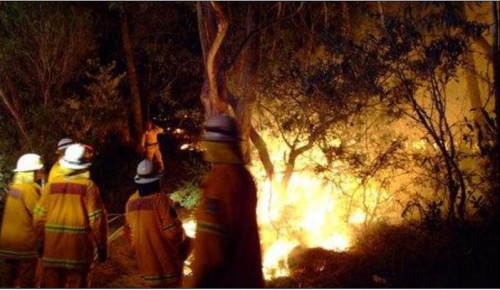 Fire-lighters look on during the Hazard Reduction Burn, Bonnie Doon Reserve Fire-lighters look on during the Hazard Reduction Burn, Bonnie Doon Reserve
.
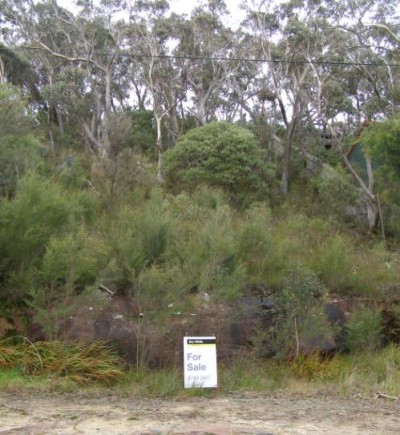 More bushland for sale
~ a ‘lose-lose’ outcome for native habitat and the remnant disappearing wildlife is supports.
More bushland for sale
~ a ‘lose-lose’ outcome for native habitat and the remnant disappearing wildlife is supports.
.
An harbinger of more burning for Bonnie Doon:
.
Of the eleven odd hectares of the 22 ha Bonnie Doon Reserve targeted by the RFS for slashing and burning on the hazard reduction certificate, nine hectares of bushland and escarpment heathland still stands to be burnt, which could happen anytime.
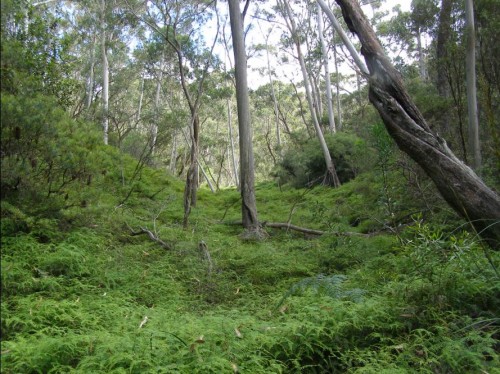 Bonnie Doon Reserve
on the western fringe of Katoomba township Bonnie Doon Reserve
on the western fringe of Katoomba township
(click photo to enlarge)
(Photo by us, so free in public domain)
.
– end of article –
.
 Blue Mountains escarpment is slashed a kilometre west of the house site Blue Mountains escarpment is slashed a kilometre west of the house site
, in preparation for over 11 hectares of buring Bonnie Doon Reserve
Tags: Blue Mountains City Council, Blue Mountains National Park, Blue Mountains World Heritage Area, Bonnie Doon Reserve, bush block for sale, bush fringe development, bush profits, bushland housing, Dwarf Mountain Pine, extreme bushfire risk, hazard reduction, hazard reduction certificate, housing encroachment, Leionema lachnaeoides, Microstrobos fitzgeraldii, property development, real estate land sales, Rural Fire Service, slashing
Posted in Blue Mountains (AU), Threats from Bushfire, Threats from Deforestation, Threats from Development | No Comments »
Add this post to Del.icio.us - Digg
Saturday, May 21st, 2011
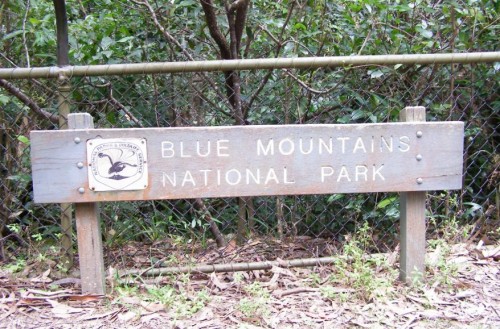
Wildlife Service sets fires to another 3000ha of World Heritage bushland
.
Last Wednesday (18th May 2011) right across the Blue Mountains, thick smoke choked the sky in a eye watering haze. By Friday, an artificial red sunset was blazing through the wood smoke at the end of two days of New South Wales government-sponsored bush arson.
I knew exactly the ecological disaster unfolding, out of sight out of mind.
In its annual misguided winter ritual, the National Parks and Wildlife Service (Wildlife Service), aided and abetted by the Rural Fire Service has deliberately setting fire to remote bushland across The Blue Mountains World Heritage Area – a ‘natural planet asset’ of which the Wildlife Service is international custodian.
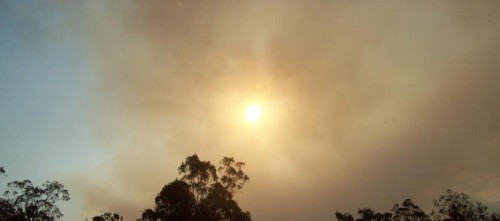
.
Linden Ridge HR Ops (May 2011)
.
On Wednesday afternoon 18th May 2011, the aerial incendiary bombing commenced at Linden Ridge and extended down to the Grose River inside the Blue Mountains National Park (within designated wilderness within the World Heritage Area). Bushfire management euphemistically call it ‘hazard reduction‘ (HR) ; rejecting any notion that bushland habitat is a natural asset, and instead demonising it as a ‘hazard’.
.
Massif Ridge HR Ops (May 2010)
.
The Linden Ridge ‘ops’ follows an almost identical HR ‘ops’ conducted the same time last year on 12 May 2010 in which aerial incendiary ‘ops’ commenced around Massif Ridge some 12 kilometres south of the town of Woodford in wild inaccessible forested area of the World Heritage Area. Some 2500 hectares of high conservation habitat bushland in a protected wilderness area called the ‘Blue Labyrinth’ was indiscriminately incinerated – ridgetops, gullies, everything. Refer to previous article on this website: >’National Parks burning biodiversity‘.
The same Blue Mountains National Park has been targeted by the same aerial incendiary bombing by the same Wildlife Service. Both the operations were carried out under the orders of the Blue Mountains regional manager, Geoff Luscombe.
 This is reducing the ‘hazard’
Click photo to enlarge, then click again to enlarge again and look for anything living.
After a year look for the animals.
After two years look for the animals…. This is reducing the ‘hazard’
Click photo to enlarge, then click again to enlarge again and look for anything living.
After a year look for the animals.
After two years look for the animals….
.
.
.
Gross Valley Defacto HR Ops (Nov 2006)
.
Both the above HR Ops follow the massive conflagration of November 2006, infamously recalled across the Blue Mountains community as ‘The Grose Fire‘. Two abandoned lightning strikes coupled with HR Ops along the Hartley Vale Road and escaping backburns coalesced and incinerated an estimated 14,070 hectares of the Grose Valley and adjoining ridge lands, much of which is designated wilderness. Many consider the actions of the bushfire management response in hindsight to have been a defacto hazard reduction burn. With such an effective elimination of the natural ‘hazard’ that year, as well as the public outrage, HR Ops went quite for four years.

How many animals native to this beautiful Grose Valley suffered an horrific burning death?
How many of their kind have now perished forever from the Grose?
…ask your Wildlife Service at Blackheath!
Charles Darwin in 1836 counted platypus in the area.
.
The perverted rationalisation by bushfire lighting theorists who have infiltrated the Wildlife Service is that the natural bushland, forests and swamps of the Blue Mountains World Heritage Area are perceived not as a valuable natural asset, but as a world ‘hazard’ area to be feared and ‘to be burned in case they burn‘.
These same bushfire lighting theorists have effectively infiltrated, appeased and silenced local conservation groups such as the otherwise very vocal Blue Mountains Conservation Society, the National Parks Association of New South Wales and the umbrella conservation group the New South Wales Conservation Council.
The local conservation movement’s complicity to sanction explicit broadscale ecological harm is a disgraceful and ignoble abandonment of cherished core values, and a breach of duty to faithful environmental membership.
.
.
.
Broadscale indiscriminate ‘HR’ is no different to wildfire or bush arson
The Linden Ridge and Massif Ridge HR Ops were approved and executed by government in the name of ‘hazard reduction’ – to reduce the available ‘fuel’ (native vegetation) for potential future wildfires or bush arson. In both cases, the massive broadscale natural areas burnt were not careful mosaic low intensity burning around houses. This was broadscale indiscriminate fire bombing of remote natural bushland many miles from human settlement. How can the deliberate setting alight of bushland where no fire exists, where no human settlement requires protection from the risk of wildfire be construed but anything other than ‘government-sanctioned bush-arson‘?
.
The ‘Ecological Burn’ Myth
.
When bushfire management can contrive no other excuse for setting fire to native vegetation, such as when that vegetation is many miles away from human settlement and so poses no direct threat, out comes the concocted theory of the ‘ecological burn’. The ‘ecological burn’ theory starts with the premise that because humans have observed that the Australian bush ‘grows back’ (eventually) after a bushfire, it may be concluded that the Australian bush can tolerate bushfires. This hypothesis relies on evidence that selected species of Australian germinate after smoke and fire and the example of epicormic growth of many Eucalypts after fire.
The first deductive fallacy of this theory is that all the Australian bush is bushfire tolerant. This deduction is then extended by unsupported assumption that since the Australian bush is bushfire-tolerant, bushfire must be an integral natural process to which the Australian bush has become adapted to bushfire. The assumption is then extrapolated to assert that bushfire is indeed beneficial to the Australian bush. The assumption is then stretched even further to conclude that without bushfire the Australian bush will be adversely affected. The ecological burn theory then prescribes that by burning the Australian bush, whether by natural or unnatural means, the biodiversity of the Australian bush will be improved.
The deductive fallacy goes further, to suit the motives of the fire-lighters. The outrageous generalisation is made that all the Australian bush must be burnt at some stage for its own ecological benefit. ‘So go forth and burn it. The bush will grow back. It will do it good.’
.
The perverted irrational logic that Australia’s native vegetation has adapted to recover from fire, is akin to claiming the human body is adapted to recover from injury such as burns. A wound may heal but no-one seeks to be injured in the first place. And not all wounds heal. A third degree burn to more than 50% of a human body is almost a certain death sentence. What percentage of a wild animal’s body can be burnt and the animal still survive? That’s a perverted question for the fire-lighters.
Broadscale hazard reduction is not mosaic patch-work fire. It is not creating a small scale asset protection zone around the immediate boundary of a human settlement. It is wholesale bush arson that is driving local extinctions. Ever wonder why when bushwalking through the Australian bush so few native animals are seen these days? Their natural populations have been decimated through two centuries of human harm – mainly poaching, introduced predation and habitat destruction including by human-caused bushfires and human-abandoned bushfires.

The recent concept of the so-called ‘ecological burn’ is a contrivance, a myth. It is a false cause fallacy. Ecological fire a defunct scientific theory contrived by bushfire management engaging unemployed graduates to think up an idea for a PhD. It belongs in the same discarded bucket of defunct scientific theories from days of yore of such ilk as ‘alchemy‘, ‘phlogiston‘, ‘flat earth‘, ‘hollow earth‘ and ‘the birth cries of atoms’ theories. Yup, these were once believed.
[Source: http://www.shortopedia.com/O/B/Obsolete_scientific_theories].
.
The effect on wildlife habitat by broadscale ‘hazard’ reduction is no different than if it was caused by wildfire or bush arson. The hazard to wildlife habitat is the same. The broadscale blanketing of bushland with high intensity burns that reach into the tree tops and scorching ground cover and earth, present the same intense fire regime. The landscape is laid to waste in just the same way as wildfire or bush arson does. Habitat and the wildlife it accommodates become the innocent victims of horrific bushfire, no matter how caused.
There is no wildlife monitoring before, during or after one of these aerial incendiary ‘ops’. Aerial incendiary guarantees no discretion between fire sensitive habitat and fire-resilient habitat. It is a simplistic, convenient a cheap one-size-fits-all solution that re-colours the fire maps to appease political masters. The chopper boys are given their bombing co-ordinates and then do their search and destroy mission. These airborne lads should apply their skills to good and not evil. They should stick to improving their water bombing skills, not participating in this perverted fire-lighting culture.
When the rains follow, the thin yet vital topsoils get washed away into the gullies and streams. This erodes the landscape and prevents regrowth of many flora species due to the lack of vital nutrients. After both the Massif Ridge HR and the Linden Ridge HR, heavy rains did follow.
Only the species of flora adapted to bushfire recover. Fire sensitive species of flora are eliminated from the landscape. Name one species of fauna that is fire tolerant. Where are the zoologists in the Wildlife Service to tell of the impact of the HR? If this mob is providing a ‘service’, it certainly ain’t providing a service to wildlife.
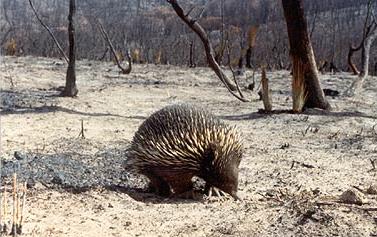
.
.
.
Wildlife Service chief boasts of mass incineration of 92,000 ha of National Parks
.
And the Wildlife Service regional chief for the Blue Mountains region, Geoff Luscombe, in his media release 17th May 2011 boasted of his:
“3000 hectare burn” that “the NPWS carried out more than 92,000 hectares of hazard reduction in 269 burns in 2009/10 – its biggest ever program.”
.
To put this area into perspective, in terms of the Blue Mountains World Heritage Area of about 1 million hectares, such a hazard reduction programme over a decade would decimate the Blue Mountains completely. And they call themselves a ‘Wildlife Service’?
Once again thousands of hectares of pristine flora and fauna habitat in deep inaccessible terrain, miles from houses and human property, has been incinerated from the air using contracted aircraft dropping indiscriminate aerial incendiaries. If only these boys had napalm!
Luscombe confirms in his media release…
“An aircraft will be used to manage the burn as most of the burn will take part in remote areas of the Blue Mountains.”
.
This incineration of natural wildlife habitat is justified by the Wildlife Service as ‘strategic‘ and ‘hazard reduction‘ operations are one of many being conducted by NPWS around the state making the most of the dry sunny winter conditions. This burn is part of the NPWS annual fire management program.
Luscombe again:
…“reducing the volume of fuels within strategic areas of the Park, can assist in limiting the intensity and rate of spread of a wildfire in the area.”
.
Then on Friday 20th May 2011, vertical plumes of smoke were seen rising from Cedar Valley south of the Jamison Valley ~ another one of these secret HR aerial incendiary black ops that the public is not supposed to know about? No notice on either the Blue Mountains Rural Fire Service site or the Wildlife Service site. Out of sight, out of mind.
.
.
.
‘Strategic Fire Management Zones’ – a symptom of a bushphobic cult out of control
.
Under the Blue Mountains Bushfire Management Committee which governs the Blue Mountains region, ‘environmental assets’ are restricted to “threatened species, populations and ecological communities and Ramsar wetlands, locally important species and ecological communities, such as species and ecological communities especially sensitive to fire.”
So how does aerial incendiary discriminate when setting fire to a contiguous 2500 hectares or 3000 hectares of wilderness?
Answer: It doesn’t , it doesn’t seek to, it doesn’t care. The guidelines are only to keep the greenies happy. It’s called ‘greenwashing’.
The Wildlife Service in its official Fire Management Strategy, has relegated 97.7% of the Blue Mountains National Park into either what it calls ‘Strategic Fire Advantage Zones’ or else ‘Heritage Zones. In essence, heritage Zones are valued natural areas that are protected from fire, whereas the Strategic Fire Advantage Zones are expendable. The Wildlife Service proclaims that …due to the ‘relative lack of practical fire control advantages’ (lack of access and resources), Strategic Fire Management Zones are ‘managed’ to protect community assets… to reduce fire intensity… assist in the strategic control… to contain bush fires and to strengthen existing fire control advantages.
All of which simply means is that it is expendable and can and should be burnt in case it burns. Strategic Fire Management Zones ‘are considered priority for ‘treatment‘ – read targeted for broadscale indiscriminate aerial incendiary. So 2500 hectares of wilderness around Massif Ridge copped it last winter and 3000 hectares of wilderness around Linden Ridge copped it this winter. If it’ red on the fire map, burn it!
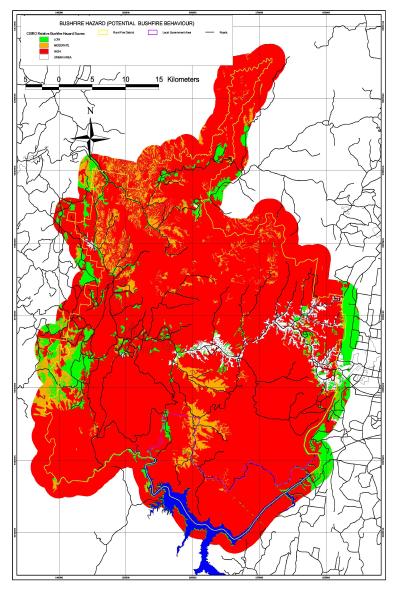
What do these ecological vandals get up to deep in the wilderness at night with their matches and petrol drip torches out of the direct view of the public? They put up signs to deny public access to their nefarious activities. Out of the public view, they are out of sight out of mind.
A cult is a group whose beliefs or practices are considered abnormal or bizarre. Starting large bushfires would seem to fit that definition. Fire-lighting is a cult of ecological deviance, just like any form of arson.
.
.
Precautionary principle ignored
.
“Where there are threats of serious or irreversible environmental damage, lack of full scientific certainty should not be used as a reason for postponing measures to prevent environmental degradation.” [Source: Principle 15 of the Rio Declaration (1992)] Such is the internationally agreed precautionary principle which Australia has adopted as a guiding principle of environmental management. The National Strategy for Ecologically Sustainable Development (1992) adopts the precautionary principle as a “core element” of ESD as does the Inter-Governmental Agreement on the Environment, and the Wildlife Service is supposed to be bound by it in its management of National Parks.
The Wildlife Service once a trusted upholder of the science-based ‘precautionary principle‘ has of late succumbed to the more red neck bushphobic fear of the bush. What the general public hears about the Wildlife Service these days is its broadscale fire bombing of vast areas of vegetation in its ‘protected’ National Parks. This is confirmed these days by the wood smoke-filled air choking many communities and responsible for unknown volumes of smoke emissions contributing to net human-caused pollution to the planet – what many call ‘climate change’.
In the Wildlife Service’s Plan of Management for the Blue Mountains National Park the only reference to the precautionary principle is “Maximum levels of total commercial recreational use in the park will be set for particular activities and particular locations according to precautionary principles.” (p.84) In its Fire Management Strategy for the Blue Mountains, the only reference to the precautionary principle is “the precautionary approach will generally be applied in the absence of specific information.” (p.53)
Clearly the Wildlife Services respect for the precautionary principle is tokenistic, and wholeheartedly disregarded with its use of aerial incendiaries. The Blue Mountains delicate ecosystems are vulnerable to the indiscriminate fire regimes being imposed upon them. The burning into the tree canopy, the broadscale contiguous burning, the scorching of the landscape until bare earth can be seen is highly damaging to the many micro ecosystem across the Blue Mountains. When such burning occurs what happens to the micro-organisms, fungi species and the natural soil biota?
.
” Much hazard reduction is performed to create a false sense of security rather than to reduce fire risks, and the effect on wildlife is virtually unknown.”
~ Michael Clarke (Associate Professor, Department of Zoology, La Trobe University, 2008)
.
.
.
.

A discredited Wildlife Service
.
The once trusted and respected Wildlife Service has lost its conservation way. It now spends more time, money and training on burning fragile ecosystems in its National Parks and exploiting those same parks for tourism exploitation, than it does on wildlife habitat rehabilitation. Sydney’s Taronga Zoo has become far more active and valuable in its urban wildlife recovery programmes than the Wildlife Service is in the wild.
At the carpark above Katoomba Falls within the Blue Mountains National Park, a rather old and deteriorating sign put up by the Wildlife Service years ago, conveys a conservation message to park users. The last two sentences are particularly poignant in light of the massive scale of broadscale bush arson repeatedly being inflicted by the protectorate of the National Park – the Wildlife Service. If only the Wildlife Service would “leave nothing but footprints” and follow its own maxim.
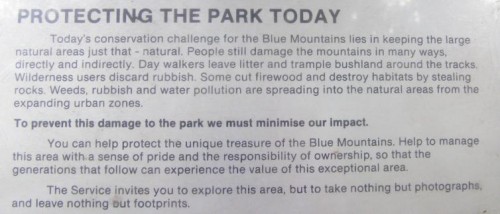
Indiscriminate bush arson of remote bushland in a National Park shows that the Wildlife Service has descended into a predatory wolf in sheep’s clothing. It’s management cannot be trusted with its custodial responsibility to protect the unique treasure of the Blue Mountains.
Once I had a desire to embark on a career as a National Parks Ranger. Had I, in the end, I would have morally wrestled with the hypocritical politics and lasted less than the initial probationary period. I empathise with those who hold a personal commitment to ecology and environmentalism within the Wildlife Service.
.
.
.
The key drivers of the ‘HR Culture’
.

The perverted and unquestioned rush to set fire to as much bushland as possible across the Blue Mountains and indeed across Australia is being driven by five cultural factors:
- ‘Ecological Fire’ Myth. (as described above) Certain ”fire ecologists’ (a self-described term for many seeking to make this a lucrative profession) who are funded by bushfire management agencies, not surprisingly have conjured the academic theory that burning the bush is good for it because it increase biodiversity – just what bushfire management with their cheque book want to hear! They have conjured the term ‘ecological fire‘, which as a euphemism sounds good, so it must be good. So those setting fire to the bush may have no moral qualms. Crap. Show me any native fauna that proliferate after fire – ‘ecological’ or otherwise!
- Under-Resourced. Bushfire management is being repeatedly denied the necessary resources and technologies to quickly detect, respond to and suppress bushfore ignitions as and when they do occur, so there is a mindset of futile frustration that nothing can be done to stop bushfires frequently getting out of control.
- Bushphobic Extremists have become effective in their fear campaign to influence natural land managers, politicians and the media in their one dimensional theory that if bushland is not burnt to remove ‘fuel loads’ catastrophic firestorms will inevitably bring forth Armageddon. They preach that only the wholesale removal of forests will prevent wildfire. (Replacement with concrete would prevent it too.) Their constant evangelising reaches such irrational hysteria, that in order to appease them, HR Ops are promised and executed just to keep them at bay.
- False Sense of Security. ‘Much hazard reduction is performed to create a false sense of security’ (James Woodford, 8-9-2008). But how is burning remote bushland many kilometres from the human interface, allaying human security concerns? Yet hazard reduction is known to directly cause a sharp increase in fuel loads due to an unnaturally high and uniform germination of understory plants.
- Winter Idleness. Fire fighting naturally quietens off during the cooler wetter month of winter, and since Australian bushfire management agencies in the main only do bushfire management rather than throw on an SES jacket, multi-task in complimentary emergency management; many bushfire agencies are perceived (rightly or wrongly) as being idle over winter. So HR gives ’em all something to do!
.
.
.
The Wildlife Service must ‘love the smell of napalm (and smoke) in the morning’
.

The Wildlife Service undertaking these remote HR Ops, sending in the airborne firelighters, must be like watching the Huey helicopter beach attack scene in Francis Coppola’s 1979 film Apocalypse Now, based on Joseph Conrad’s novel ‘A Heart of Darkness’. Colonel Kilgore in his black Confederate cowboy hat shouts:
“We’ll come in low out of the rising sun, then about a mile out we’ll put on the music; scares the hell out of the slopes.”
Richard Wagner’s “Ride of the Valkyries” is played and the boys play war games with real aircraft and real fire and causing real death and destruction.

A giant napalm strike in the nearby jungle dramatically marks the climax of the battle. Kilgore exults to Willard, “I love the smell of napalm in the morning… The smell, you know that gasoline smell… Smells like … victory”, as he recalls a battle in which a hill was bombarded with napalm for over twelve hours.

The Wildlife Service aerial incendiary boys must think of themselves as Special Forces. Perhaps there is a Colonel Kurtz among them – like an insane killer operating deep inside Laos. Kurtz’ final lines in the film are “The horror! The horror!” How comparable with what is happening deep inside Australia’s wilderness areas, out of sight out of mind? …with extreme prejudice!

How comparable is the US secret war fire bombing of Vietnam, Cambodia and Laos during the Vietnam War with the out of sight fire bombing by the Wildlife service of vast areas of Australia’s natural landscape?
The legacy of the Wildlife Services’ aerial incendiary campaigns deep inside National Parks will be one remembered for fire bombing wildlife habitat from once natural and densely vegetated into a one unnatural, sterile and ghostly quiet.
When it is too late, hazard reduction will be acknowledged by our children as naiive threatening process of our generation that drove Australia’s remaining wildlife into extinction.
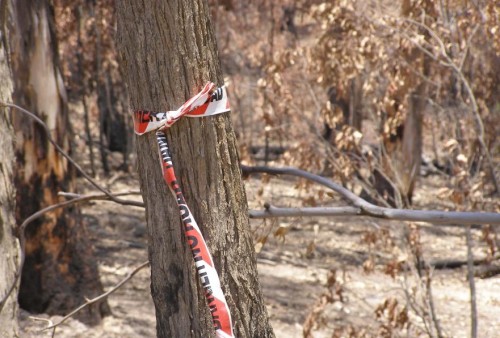
.
.
Further Reading:
[1] ‘ Catering for the needs of fauna in fire management: science or just wishful thinking?’ by Michael F. Clarke, Wildlife Research, Vol. 35 No. 5 Pages 385 – 394, Published 19 August 2008, ‘Ecological fire management in Australia is often built on an assumption that meeting the needs of plant species will automatically meet the needs of animal species. However, the scarcity of..’. ‘Wildlife Research: Ecology, Management and Conservation in Natural and Modified Habitats’, a CSIRO Journal, ISSN: 1035-3712, eISSN: 1448-5494, Available for subscription at http://www.publish.csiro.au/index.cfm
[2] ‘ The dangers of fighting fire with fire‘, by James Woodford, Sydney Morning Herald, 20080908, p.11, http://www.smh.com.au/news/opinion/the-dangers-of-fighting-fire-with-fire/2008/09/07/1220725850216.html (Accessed 20110523).
-end of article –
Tags: aerial incendiaries, applied ecology, blue labyrinth, Blue Mountains National Park, Blue Mountains wildlife, Blue Mountains World Heritage Area, bushfire myth, bushfire tolerant, bushphobic, conservation biology, ecological burn, fire-lighting cult, fuels, government bush-arson, greenwashing, Grose Valley Fires 2006, hazard reduction, heritage zone, koala extinction, leave nothing but footprints, Linden Ridge HR, Massif Ridge HR, NPWS, precautionary principle, prescribed burning, RFS, strategic fire advantage zone, strategic fire management zone, wildfire, Wildlife Service
Posted in Blue Mountains (AU), Threats from Bushfire | No Comments »
Add this post to Del.icio.us - Digg
Saturday, May 14th, 2011
In the north-western area of the Blue Mountains region of New South Wales (eastern Australia) lies the ancient Gardens of Stone. The area is so named because of its spectacular and rare sandstone rock formations known as ‘pagodas’ (large tapered, stepped or laminated sandstone formations) along with the abundance of native flora and fauna that thrive there.
Yet since November 2009, part of this beautiful pagoda country (some 1088 hectares of the Ben Bullen State Forest) with its important wildlife habitat, has come under threat of destruction from proposed open cut coal mining.
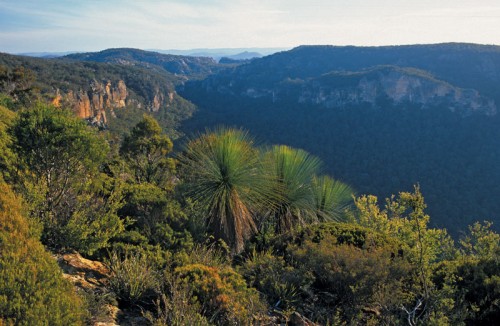 Johnson’s Grass Trees on Genowlan Mountain
© Photo by Jaime Plaza van Roon
(click photo to enlarge) Johnson’s Grass Trees on Genowlan Mountain
© Photo by Jaime Plaza van Roon
(click photo to enlarge)
.
Gardens of Stone National Park
.
In 1994, a Gardens of Stone National Park was created covering 15,000 hectares and joining Wollemi National Park on the northern part of Newnes Plateau. Other large landscape features include the outstanding mesas of Donkey Mountain in the Wolgan Valley and Pantoneys Crown in the Capertee Valley. Pantoneys Crown was previously protected in a much smaller nature reserve, and is the centrepiece of the commanding view of the valley from Pearsons Lookout on the Castlereagh Highway.
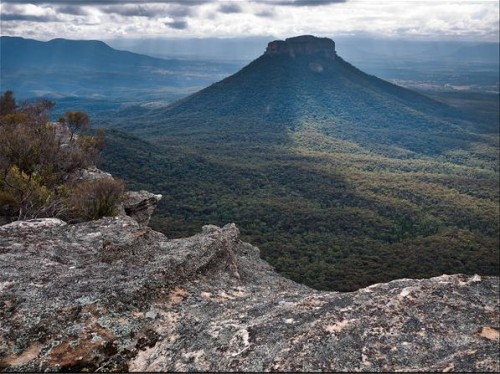 Pantoneys Crown, Gardens of Stone National Park, NSW
© Photo by David Braddon-Mitchell
[Source: ^http://dbm305.smugmug.com/Other/Pantoneys-Crown/13102823_B2fHx#950356269_VhEUF]
(click photo to enlarge) Pantoneys Crown, Gardens of Stone National Park, NSW
© Photo by David Braddon-Mitchell
[Source: ^http://dbm305.smugmug.com/Other/Pantoneys-Crown/13102823_B2fHx#950356269_VhEUF]
(click photo to enlarge)
.
Gardens of Stone Proposed Stage 2
‘But Gardens of Stone is an unfinished park. Environment groups, including Blue Mountains Conservation Society, have advanced a plan to protect much more of this unique landscape, by extending the park and creating a new state conservation area over adjacent plateaus and escarpments which are presently state forest and Crown land. The overall proposal is known as Gardens of Stone Stage 2, situated just north of the town of Lithgow. (The state conservation area classification allows underground coal-mining to continue.)
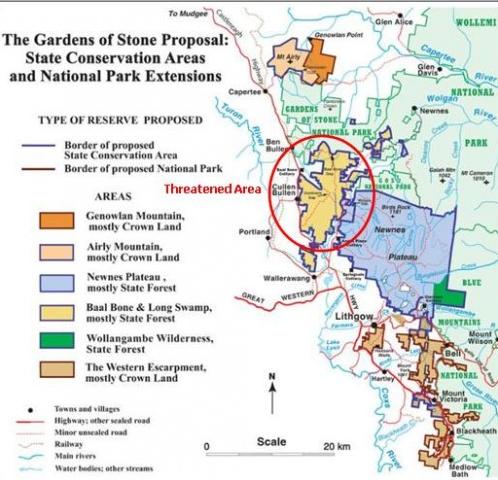 [Source: ^http://www.bluemountains.org.au/gos2.shtml] [Source: ^http://www.bluemountains.org.au/gos2.shtml]
‘These unprotected areas are just as valuable as the existing park, and are rich in special environments such as pagodas and canyons, nationally endangered high altitude shrub swamps and an unusual heathland on Genowlan Mountain. Rare and threatened species include the beautiful yellow Pagoda Daisy, Deane’s Boronia, Blue Mountains Water Skink, Wolgan Snow Gum, Giant Dragonfly, Regent Honeyeater, Genowlan Pea and Beautiful Firetail. In the western parts of the area the moist mountain vegetation begins to give way to drier inland communities, including grassy box woodlands, one of the most diminished and threatened environments in Australia.
‘The Gardens of Stone Stage 2 provides one of the most beautiful displays of sandstone geodiversity in Australia, comprising dramatically coloured sandstone escarpments and promontories, narrow canyons, cave overhangs, swamps and the complex arrays of rock pinnacles known as pagodas. The area has one of the Blue Mountains’ areas of highest plant diversity including ancient windswept montane heathlands, nationally endangered upland swamps, a unique species of snowgum (E. gregsoniana) and other high plateau woodlands representing the highest development of native vegetation on Sydney Basin sedimentary rocks, poorly conserved grassy white box woodlands on slopes below the sandstone, fascinating oil shale mining ruins on spectacular Airly Mesa, and outstanding Aboriginal cultural sites on and around Newnes Plateau.
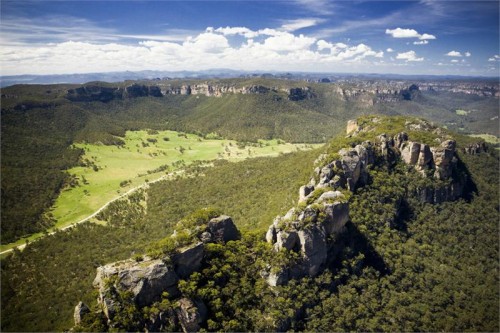 Gardens of Stone
© Photo by Hamilton Lund, Tourism NSW
Blue Mountains – Visit NSW, ^http://www.visitnsw.com/destinations/blue-mountains (click photo to enlarge) Gardens of Stone
© Photo by Hamilton Lund, Tourism NSW
Blue Mountains – Visit NSW, ^http://www.visitnsw.com/destinations/blue-mountains (click photo to enlarge)
.
The area embraces the last unprotected part of the 1934 Greater Blue Mountains National Park proposal compiled by Myles Dunphy for the National Parks and Primitive Areas Council. It also includes the Blue Mountains Western Escarpment lands from Blackheath to Lithgow. The Gardens of Stone Stage 2 proposal advanced by The Colong Foundation for Wilderness, the Blue Mountains Conservation Society and the Colo Committee is to include all of the remaining parts of Newnes Plateau and surrounding sandstone uplands – an area of 40,000 hectares. It would protect the most spectacular pagoda landscapes in Australia.
Associated with these pagoda landforms are found large caves, mazes, ancient montane heathlands, endangered upland swamps, snowgums, grassy woodlands and moist gullies that contain tree ferns, stands of old growth forest and rainforest, and, in some places, slot canyons.
Reservation of Stage Two would also secure the outstanding ochre coloured cliffs of the Blue Mountains’ Western Escarpment and the rare plant communities that lie above them. Reservation of the remaining unprotected parts of the Gardens of Stone as a State Conservation Area is urgently required to rein in ongoing and accelerating environmental degradation.
[Sources: Gardens of Stone National Park, http://www.worldheritage.org.au/resources/national-parks/gardens-of-stone-national-park/ and Blue Mountains Conservation Society, http://www.bluemountains.org.au/gos2.shtml]
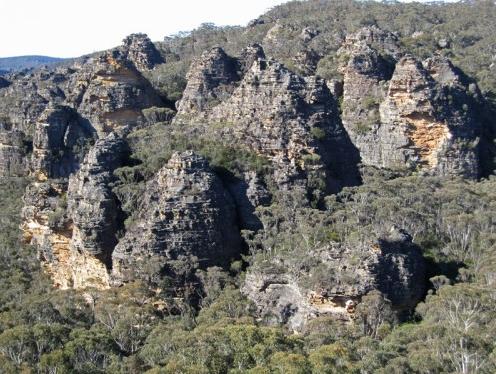 Pagodas of the Gardens of Stone (still outside the National Park) Pagodas of the Gardens of Stone (still outside the National Park)
© Photo by Andrew Valja
[Source: Blue Mountains Conservation Society, http://www.bluemountains.org.au/gos2.shtml]
(click photo to enlarge)
.
.
.

Threats from Coalpac Pty Ltd
.
CoalPac is a private Queensland coal mining company headquartered in Pullenvale in outer eastern Brisbane. In 1989, CoalPac took over coal mining operations outside the town of Lithgow in New South Wales, at the Cullen Valley Open Cut Mine and the Invincible Open Cut Mine. The Mines currently operate at 2 mtpa and Coalpac has plans for significant expansion of coal mines in the Gardens of Stone area.
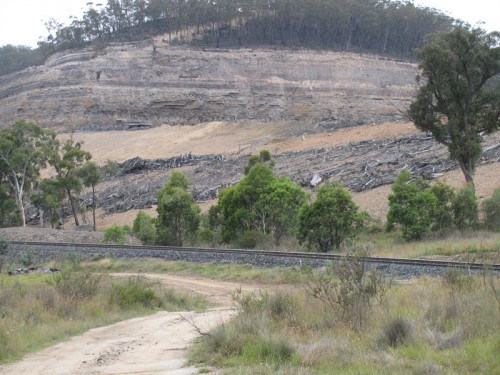 Coalpac’s CullenValley Mine
[Source: Lithgow Environment Group, Inc.]
(click photo to enlarge) Coalpac’s CullenValley Mine
[Source: Lithgow Environment Group, Inc.]
(click photo to enlarge)
.
‘Coalpac is seeking approval for the consolidation and expansion of the existing Cullen Valley Mine and Invincible Colliery operations to produce up to a total of 3.5 million tonnes per annum.’ [Source: http://cetresources.com/about-us]
This proposed extension of its open-cut and highwall mining will intrude into a large area of the publicly-owned Ben Bullen State Forest (BBSF), NSW. The extension area is equivalent of 2,176 football fields of predominantly old growth forest will be clear-felled and excavated if this goes ahead. The pagoda’s features and stability may be threatened by collapse.
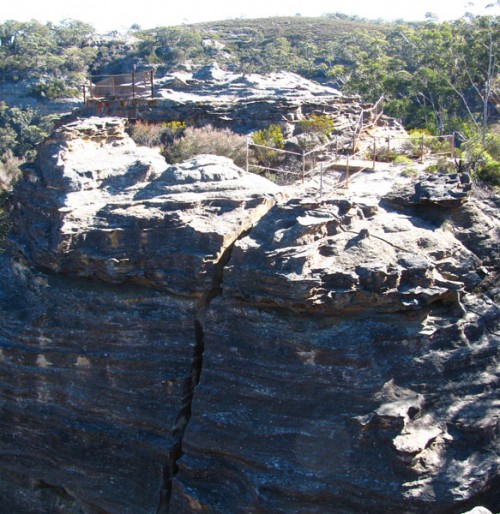 Cracked Hassans Walls, Lithgow ~ caused by nearby mining
[Source: Lithgow Environment Group, Inc.] Cracked Hassans Walls, Lithgow ~ caused by nearby mining
[Source: Lithgow Environment Group, Inc.]
.
“The NSW National Parks and Wildlife Service (now within the Office of Environment and Heritage) has acknowledged its wish to add BBSF to the conservation reserve system as a matter of priority” says Lachlan Garland, President of the Blue Mountains Conservation Society.
“Allowing this operation would mean the equivalent of 2,176 football fields of predominantly old growth forest of the BBSF being clear-felled and excavated.
“This forest is a publicly-owned area of conservation and recreational importance. The community expects state forests to be protected from destruction in perpetuity.
 ‘Baal Bone Creek’ area at risk
©Photo by Ian Brown.
‘Baal Bone and Long Swamp (7,800 hectares) comprise massed pagoda ‘villages’ above the Long Swamp, a diverse swampy plain. They collectively form an evocative landscape of broken stone, reminiscent of Cambodia’s forest of State Forest temples, while nearby indigenous cave art honours this landscape.’
(click to enlarge, then click again to enlarge further) ‘Baal Bone Creek’ area at risk
©Photo by Ian Brown.
‘Baal Bone and Long Swamp (7,800 hectares) comprise massed pagoda ‘villages’ above the Long Swamp, a diverse swampy plain. They collectively form an evocative landscape of broken stone, reminiscent of Cambodia’s forest of State Forest temples, while nearby indigenous cave art honours this landscape.’
(click to enlarge, then click again to enlarge further)
.
“Habitats for the Regent Honeyeater, Tiger Quoll and Powerful Owl and at least 32 threatened native animals, 5 of which are listed under the EPBC Act, will be completely removed.
“Our iconic Lyrebirds also use the sides of pagodas to nest and raise their young. Mining will completely remove the protective pathways for adult birds foraging between nesting sites and will destroy their food habitats within the more fertile valley floors.
“The effective privatisation and liquidation of a large part of the forest is an outrageous precedent that should not be set; it is a direct challenge to the state’s efforts to reduce deforestation.
“The Blue Mountains Conservation Society seeks to work with the Minister for the Environment and Heritage, Robyn Parker, to continue our important work and safeguard the future of the Gardens of Stone.
“We invite all politicians to visit the Gardens of Stone area with us on Sat 14th May, 2011 to see first hand the stunning areas under threat from mining.”
The NSW Department of Planning finalised the Director-General’s Requirements (guidelines) for the Environmental Assessment on 16 October 2010. The proponent is preparing the Environmental Assessment. Once finalised, this will be released for public comment. The project, prior to the election of the NSW Coalition Government, was to be assessed by an accredited process under Part 3A, which on 7th April 2011 was scrapped by the incoming O’Farrell Liberal Government of New South Wales. [read article below]
 The very yellow Pagoda Daisy (at risk)
©Photo by Ian Brown
(click to enlarge, then click again to enlarge further) The very yellow Pagoda Daisy (at risk)
©Photo by Ian Brown
(click to enlarge, then click again to enlarge further)
.
Environment groups take action to protect Gardens of Stone
The uniquely scenic and biodiverse Gardens of Stone is under imminent threat due to a consolidation proposal by Coalpac Pty Ltd. If approved, wildlife habitat and natural heritage will be lost forever, water systems will be stressed and there would be direct impacts for local residents. On Saturday 14th May, 2011 environment groups and their supporters will be taking action to help protect this iconic landscape from irredeemable destruction.
“Coalpac Pty Ltd seeks to extend open-cut and highwall mining into a large area of the publicly-owned Ben Bullen State Forest, NSW. The NSW National Parks and Wildlife Service has acknowledged its wish to add this forest to the conservation reserve system as a matter of priority” says Tara Cameron, Vice President of Blue Mountains Conservation Society.
“Many of the highwall scarps will abut strata directly below the ‘pagoda’ rock formations, their features and stability may be threatened by collapse. Environment groups are outraged at this proposal” says Tara Cameron.
“This forest is a publicly-owned area of conservation and recreational importance. The community expects state forests to be protected from destruction in perpetuity. If the NSW Government’s Strategic Regional Landuse Policy is to mean anything for sensitive, natural lands, then the Gardens of Stone must be protected from destructive mining operations, ” says Keith Muir, Director of Colong Foundation for Wilderness.
“This landscape is biodiversity hotspot, characterised by rich old-growth forests. Our iconic Lyrebirds use the sides of pagodas to nest and raise their young. Mining will completely remove their food habitats as well as the habitats of at least 32 threatened native animals” says Belinda Fairbrother, Campaigns Manager for The Wilderness Society NSW.
“Water management and impacts over such a large, exposed open-cut area are of great concern. The large open cut will also create significant dust and air quality issues which will impact directly on local residents” says Caroline Graham, Vice President of Rivers SoS.
“Environment groups are calling on the government to reject this mining proposal and act to protect the region within a State Conservation Area. We are coming together at this event to send a clear message that ‘We say No to open cut mining!’ in this iconic area of our state” says Kevin Evans, EO of National Parks Association of NSW.
“Across NSW, areas of high conservation value and great beauty are under threat from the rapid expansion of the coal and coal seam gas industries. During this time of transitional arrangements on the regulation of coal mining, the State government has an opportunity to deliver on its promise of better protection of water resources and the environment by rejecting further mining at the iconic Gardens of Stone,” says Pepe Clarke, CEO of the Nature Conservation Council of NSW.’
[Source: National Pars Association of NSW, http://www.npansw.org.au/index.php?option=com_content&view=article&id=718:environment-groups-take-action-to-protect-gardens-of-stone&catid=172:2011&Itemid=564]
.
.
‘Part 3A scrapped’
[8 Apr 11, by Tyron Butson, Southern Courier newspaper, http://southern-courier.whereilive.com.au/news/story/part-3a-scrapped/]
PREMIER Barry O’Farrell has given increased planning powers back to local councils after scrapping the controversial Part 3A amendment.
He announced the decision to drop Part 3A of the 1979 Environmental Planning and Assessment Act at yesterday’s first State Cabinet meeting.
Local councils will now have final say on many outstanding applications, while others will be referred to the NSW Planning Assessment Commission.
No new Part 3A application for residential, commercial, retail or coastal development will be accepted and the State Government hope to push through legislation that will see the amendment repealed from the Statute books when Parliament resumes.
“This means a return of planning powers to councils and local communities,” Mr O’Farrell said.
“The days of giving the Planning Minister sweeping powers to approve developments at the stroke of a pen with virtually no consultation with local communities are over.
“That extreme power only leads to the sort of suspicion and shady deals we have seen in NSW over the past 16 years.”
The scrapping of Part 3A was a core election promise of the Liberal party, but the government will still have to push legislation through the Upper House.
Mr O’Farrell said he had not attempted to convince opposition members but had directed the Minister for Planning Brad Hazzard to draw up plans.
Until then transitional arrangements will be put into place to deal with more than 500 Part 3A applications already in the system.
About half of the applications will now face the Planning Assessment Commission for assessment, while the rest will either be sent to local councils to vote on or allowed to lapse.
Part 3A was introduced in 2005 and gave planning ministers the ability to overrule local councils and communities on any project the minister deemed to be of state or regional importance.’
.
.
‘Cliffs crumbled due to coal mining, says new report’
(by Ben Cubby, Environment Editor, Sydney Morning Herald, April 27, 2010)
‘DOZENS of cliffs have crumbled or collapsed, Aboriginal rock art has been destroyed and metre-wide cracks opened in the earth as a result of coalmining in the Gardens of Stone wilderness area near Lithgow, an independent report has found.
The damage, inflicted over three decades by five coal mines and continuing today, is caused by subsidence from longwall mining, which now almost surrounds the Gardens of Stone National Park, part of the Greater Blue Mountains World Heritage Site. It is likely to be extended further if a new mine plan is approved by the NSW government.
The report, to be launched today by the former premier Bob Carr, documents wide-scale, unpublicised damage, including the destruction of some of the area’s unique sandstone pagodas and rock arches.
”In its monitoring reports to government, the coal industry regularly understates the damage caused,” said Keith Muir, the executive officer of the Colong Foundation for Wilderness, which produced the report. ”Mine operations do not work to minimise environmental damage and have been largely unresponsive to environmental concerns.”
The study based this conclusion on visual observation in the remote bushland and examination of the the environmental assessments used to justify the expansion of mining. In some cases, the assessments predicted that cliffs could crumble but no remedial action was taken.
The report looks at the six coalmines around the national park: the Angus Place, Springvale and Airly mines operated by Centennial Coal, Baal Bone and Clarence collieries operated by Coalex, and Invincible mine, operated by Coalpac. All the mining companies have met the requirements of their environmental assessment processes and have continued to monitor the impact of subsidence.
Reports produced by consultants employed by the companies showed more than 100 recorded cliff falls in the past three decades. Some led to changes in sites and techniques, but in the majority of cases the warnings were not heeded.
The damage was significantly worse above longwall mines, which cut out long, broad panels of coal, leaving the surface above to crack and subside. The Clarence and Airly mines use the bord and pillar technique, which involves leaving more coal in the ground to support the rock above, resulting in less surface damage.
Aboriginal rock art sites were also photographed with major fractures running through them and, in some cases, entire rock faces destroyed by the effects of subsidence.
”Crevasses, cliff falls and rock fractures are spoiling the sandstone beauty of the Gardens of Stone,” Mr Muir said.
The organisation is calling for a state-sanctioned conservation area that would provide a buffer zone around the park. It would cover part of the Baal Bone mine area, where a further expansion is planned, and the Newnes Plateau, where many swamps have been drained when the rock beneath them cracked open.
”The Department of Environment, Climate Change and Water has been considering proposals for additions to the Gardens of Stone National Park and an evaluation process is under way,” a spokeswoman said.
Read more: http://www.smh.com.au/environment/cliffs-crumbled-due-to-coalmining-says-new-report-20100426-tnbk.html#ixzz1MGS62mRx
.
.
Previously in 2007…
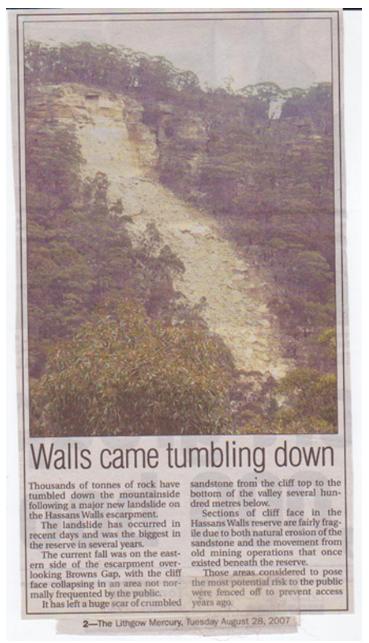
.
.
Further Reading:
.
[1] Previous article on this website: ‘Gardens of Stone at Risk from Coal Mining’, > https://www.habitatadvocate.com.au/?p=4021
[2] Blue Mountains Conservation Society, ^http://www.bluemountains.org.au/gos2.shtml
[3] Gardens of Stone National Park, ^http://www.worldheritage.org.au/resources/national-parks/gardens-of-stone-national-park/
[4] The Colong Foundation for Wilderness, ^ http://www.colongwilderness.org.au/Gardens_of_Stone/GoS2_home.htm
[5] Lithgow Environment Group, Inc. ^http://www.lithgowenvironment.org/mine_watch.html
[6] Lithgow Tourism, ^http://www.lithgow-tourism.com/gardenstone.htm
[7] Rivers SOS, ^http://riverssos.org.au/2011/04/27/help-us-protect-the-gardens-of-stone/
[8] National Parks Association of NSW, ^http://www.npansw.org.au/index.php?option=com_content&view=article&id=718:environment-groups-take-action-to-protect-gardens-of-stone&catid=172:2011&Itemid=564
[9] ‘Cliffs crumbled due to coalmining, says new report’, by Ben Cubby, Sydney Moring Herald, April 27, 2010, ^http://www.smh.com.au/environment/cliffs-crumbled-due-to-coalmining-says-new-report-20100426-tnbk.html

– end of article –
Environment groups take action to protect Gardens of Stone
The uniquely scenic and biodiverse Gardens of Stone is under imminent threat due to a consolidation proposal by Coalpac Pty Ltd. If approved, wildlife habitat and natural heritage will be lost forever, water systems will be stressed and there would be direct impacts for local residents. On Saturday 14th May, 2011 environment groups and their supporters will be taking action to help protect this iconic landscape from irredeemable destruction.
“Coalpac Pty Ltd seeks to extend open-cut and highwall mining into a large area of the publicly-owned Ben Bullen State Forest, NSW. The NSW National Parks and Wildlife Service has acknowledged its wish to add this forest to the conservation reserve system as a matter of priority” says Tara Cameron, Vice President of Blue Mountains Conservation Society.
“Many of the highwall scarps will abut strata directly below the ‘pagoda’ rock formations, their features and stability may be threatened by collapse. Environment groups are outraged at this proposal” says Tara Cameron.
“This forest is a publicly-owned area of conservation and recreational importance. The community expects state forests to be protected from destruction in perpetuity. If the NSW Government’s Strategic Regional Landuse Policy is to mean anything for sensitive, natural lands, then the Gardens of Stone must be protected from destructive mining operations, ” says Keith Muir, Director of Colong Foundation for Wilderness.
“This landscape is biodiversity hotspot, characterised by rich old-growth forests. Our iconic Lyrebirds use the sides of pagodas to nest and raise their young. Mining will completely remove their food habitats as well as the habitats of at least 32 threatened native animals” says Belinda Fairbrother, Campaigns Manager for The Wilderness Society NSW.
“Water management and impacts over such a large, exposed open-cut area are of great concern. The large open cut will also create significant dust and air quality issues which will impact directly on local residents” says Caroline Graham, Vice President of Rivers SoS.
“Environment groups are calling on the government to reject this mining proposal and act to protect the region within a State Conservation Area. We are coming together at this event to send a clear message that ‘We say No to open cut mining!’ in this iconic area of our state” says Kevin Evans, EO of National Parks Association of NSW.
“Across NSW, areas of high conservation value and great beauty are under threat from the rapid expansion of the coal and coal seam gas industries. During this time of transitional arrangements on the regulation of coal mining, the State government has an opportunity to deliver on its promise of better protection of water resources and the environment by rejecting further mining at the iconic Gardens of Stone,” says Pepe Clarke, CEO of the Nature Conservation Council of NSW.
Tags: Baal Bone, Barry O'Farrell, Ben Bullen State Forest, Blue Mountains World Heritage Area, Capertee Valley, Coal Mining, Coalpac Pty Ltd, Gardens of Stone, Genowlan Mountain, Hassans Walls, Lithgow Coal, Minister for Planning Brad Hazzard, Minister for the Environment and Heritage Robyn Parker, Newnes Plateau, Pantoneys Crown, Part 3A, Powerful Owl, Regent Honeyeater, Tiger Quoll, Wolgan Valley
Posted in Blue Mountains (AU), Threats from Mining | No Comments »
Add this post to Del.icio.us - Digg
Saturday, March 26th, 2011
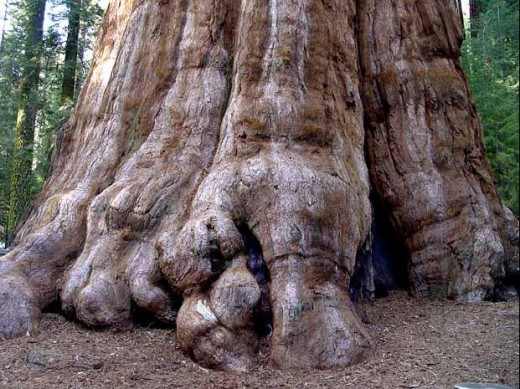 ‘General Sherman’ ~ just another sequoia? (pronounced ‘sequoya’)
Sequoia & Kings Canyon, Sierra Nevada, California, USA
^http://www.nps.gov/seki/historyculture/gfgst.htm ‘General Sherman’ ~ just another sequoia? (pronounced ‘sequoya’)
Sequoia & Kings Canyon, Sierra Nevada, California, USA
^http://www.nps.gov/seki/historyculture/gfgst.htm
.
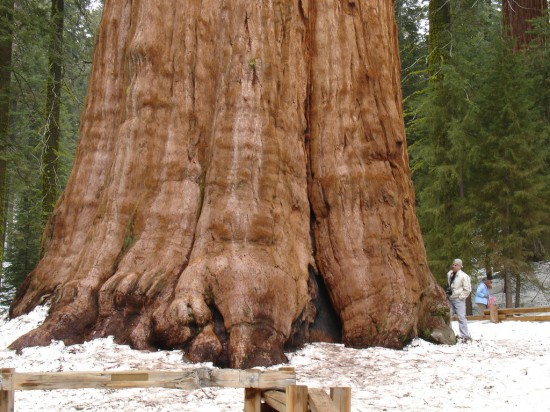 The General Sherman Tree
– the world’s largest tree, is the prime visitor attraction in the Giant Forest.
[Source: ^http://www.nps.gov/seki/historyculture/gfgst.htm]
. The General Sherman Tree
– the world’s largest tree, is the prime visitor attraction in the Giant Forest.
[Source: ^http://www.nps.gov/seki/historyculture/gfgst.htm]
.
“Sequoia sempervirens’ common names include coast redwood, California redwood, and giant redwood. It is an evergreen, long-lived, monoecious tree living 1200–1800 years or more. This species includes the (current) tallest trees on Earth, reaching up to 379 feet (115.52 m) in height and up to 26 feet (7.9 m) diameter at breast height. Before commercial logging and clearing began by the 1850s, this massive tree occurred naturally in an estimated 2.1 million acres along much of coastal California (excluding southern California where rainfall is not abundant enough) and the southwestern corner of coastal Oregon within the United States.” [Source: ^Wikipedia – read more].
.
“The Sierra Nevada is still growing today. The mountains gain height during earthquakes on the east side of the range. But the mountains are being shortened by erosion almost as quickly as they grow. This erosion has deposited sediments thousands of feet thick on the floor of the San Joaquin Valley.”
[Source: ^http://www.nps.gov/seki/historyculture/gfgst.htm]
.
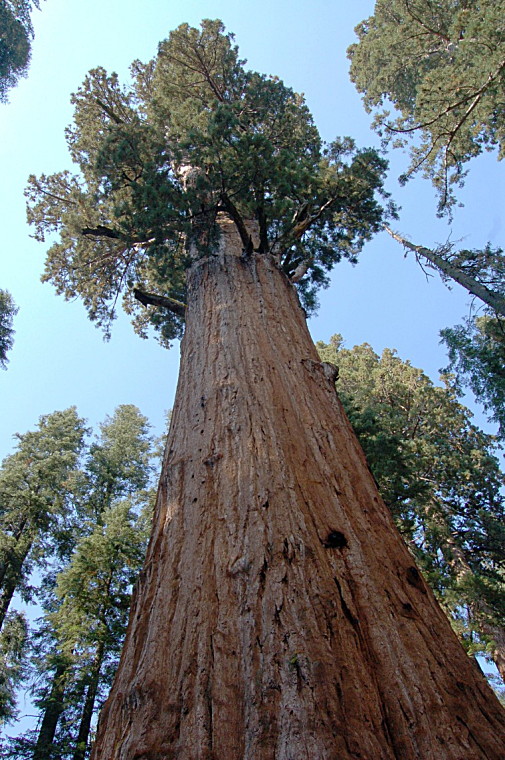
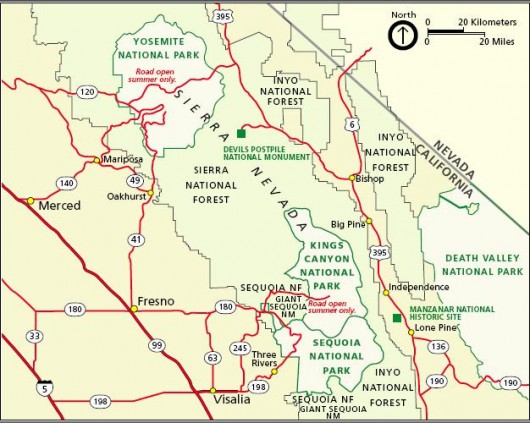
.
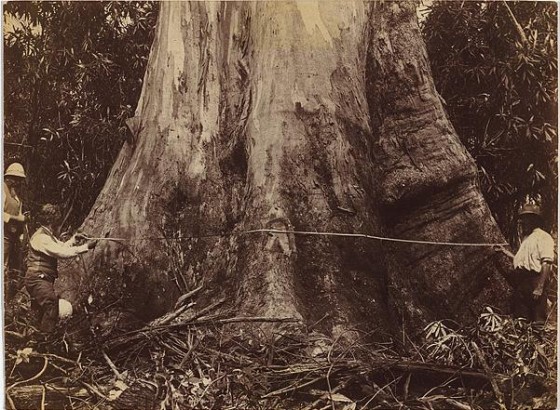 ‘Giant tree’ at Neerim (Gippsland, Victoria, Australia), forty feet girth c.1889
AUSTRALASIAN ART, Photo by Nicholas CAIRE, b.1837 Guernsey, United Kingdom – Australia d.1918[Gelatin silver photograph image 15.0 h x 20.2 w cm, Purchased 1983, Accession No: NGA 83.3083]
.
.
“The men shown here measuring the diameter of a giant eucalypt were not loggers or tree-lovers. They were attempting to determine whether Australian trees were bigger than the famed 400-foot giant redwoods of California. It was mostly national pride surrounding the Australian Centennial of European settlement which motivated scientists and photographers in the 1880s to seek out the remaining giant trees in the more remote areas of Victoria. The Americans claimed that their redwoods were the greatest because of their combined height and girth. In the dense Australian bush, it
was easier to measure the girth than the height and presented a much more dramatic image for a photograph.
.
The general public followed the giant tree debate in the papers and also purchased photographs of them and other idyllic bush scenes. By the late 19th century, the Australian population mostly lived and worked in the cities. They became day-trippers and used the new railway networks to take their recreation in the bush. Nicholas Caire, one of the most active photographers to seek out and record the giant trees, travelled over a number of years on the new rail line to Neerim town reserve.
.
Australia’s giant trees were widely depicted in colonial art as mighty symbols of the pre-settlement and pioneer era. Caire, whilst accepting the desirability of logging and urban development, was also one of those who argued for the preservation of examples for future generations.
.
Most of the awesome giant trees were felled or burnt in his lifetime. Now they are preserved only in photographs.” ‘Giant tree’ at Neerim (Gippsland, Victoria, Australia), forty feet girth c.1889
AUSTRALASIAN ART, Photo by Nicholas CAIRE, b.1837 Guernsey, United Kingdom – Australia d.1918[Gelatin silver photograph image 15.0 h x 20.2 w cm, Purchased 1983, Accession No: NGA 83.3083]
.
.
“The men shown here measuring the diameter of a giant eucalypt were not loggers or tree-lovers. They were attempting to determine whether Australian trees were bigger than the famed 400-foot giant redwoods of California. It was mostly national pride surrounding the Australian Centennial of European settlement which motivated scientists and photographers in the 1880s to seek out the remaining giant trees in the more remote areas of Victoria. The Americans claimed that their redwoods were the greatest because of their combined height and girth. In the dense Australian bush, it
was easier to measure the girth than the height and presented a much more dramatic image for a photograph.
.
The general public followed the giant tree debate in the papers and also purchased photographs of them and other idyllic bush scenes. By the late 19th century, the Australian population mostly lived and worked in the cities. They became day-trippers and used the new railway networks to take their recreation in the bush. Nicholas Caire, one of the most active photographers to seek out and record the giant trees, travelled over a number of years on the new rail line to Neerim town reserve.
.
Australia’s giant trees were widely depicted in colonial art as mighty symbols of the pre-settlement and pioneer era. Caire, whilst accepting the desirability of logging and urban development, was also one of those who argued for the preservation of examples for future generations.
.
Most of the awesome giant trees were felled or burnt in his lifetime. Now they are preserved only in photographs.”
~Anne O’Hehir
.
Indeed…
“The largest tree on Planet Earth is not the California Redwood, but the Mountain Ash (Eucalyptus regnans). The largest trees ever recorded were located in southern Australia near present day Melbourne. The world’s largest tree was the Ferguson Tree at over 500 feet (154m). It was measured by Surveyor Ferguson in 1872 in the Watts River Catchment near Healesville.”
Read More: Click: http://www.baddevelopers.green.net.au/Docs/talltrees.htm
.
Source: Text © National Gallery of Australia, Canberra 2010, Anne Gray (ed), Australian art in the National Gallery of Australia, National Gallery of Australia, Canberra, 2002, http://cs.nga.gov.au/Detail-LRG.cfm?IRN=106546&View=LRG
.
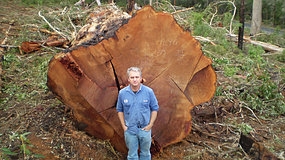
.
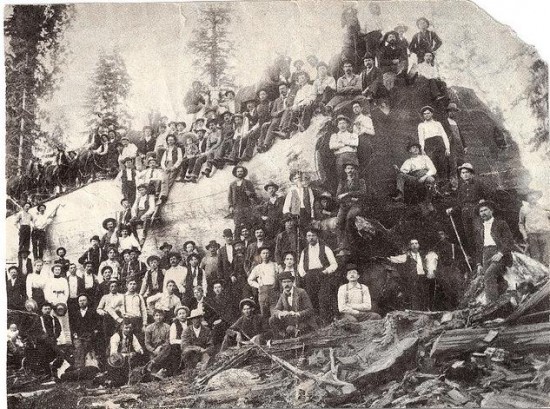 People and Horses on a Gigantic Redwood Log; about 1900.
“This photo is open for down loading for anyone wishing a free copy. Unknown Photo History. I’m fairly certain the tree was a Coast Redwood (Sequoia semperviren) or a Giant Sequoia (Sequoiadendron giganteum) from Central to Northern California or Oregon. I wish this one was still standing. The bark has already been stripped off of it.” [Source: Photo of old photo by David Foster, http://www.flickr.com/photos/21734563@N04/2225069096/] People and Horses on a Gigantic Redwood Log; about 1900.
“This photo is open for down loading for anyone wishing a free copy. Unknown Photo History. I’m fairly certain the tree was a Coast Redwood (Sequoia semperviren) or a Giant Sequoia (Sequoiadendron giganteum) from Central to Northern California or Oregon. I wish this one was still standing. The bark has already been stripped off of it.” [Source: Photo of old photo by David Foster, http://www.flickr.com/photos/21734563@N04/2225069096/]
.
.
Editor’s Comment:
I empathise with David Foster. – ‘I wish this one was still standing‘. Every face in this 1900 photo conveys cultural achievement and exploitative pride.
Now in 2011, has human attitude and on-ground impact toward ‘Old Growth’ really changed any?
Consider ‘Merbau’ timber, readily available from local timber yards across Australia and in New Zealand as ‘Kwila’ (Botanical names: Intsia bijuga and Intsia palembanica). Comparable old-growth rainforest hardwoods include Narra, Yakal, and Ipil. These old growth giants continually to be currently logged illegally deep in rain forests of the Philippines, Solomon Islands, Fiji and Papua New Guinea. Australian and New Zealand households profit from SE Asian rain forest destruction.
The lost natural assets of giant trees, of old growth have diminished the Earth, and have diminished the value of humanity, and of humanity’s value to the Earth. To forest habitat we are but marauders and rapists.
Humanity has become ‘Earth’s Pathogen’.
.
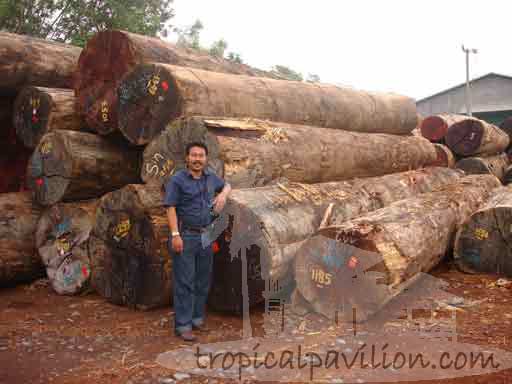 . .
 SE Asia old growth Rainforest Kwila is marketed in Australia and New Zealand as ‘Merbau’
for use mainly in flooring and decking,because of its relative hardness (high Janka rating) and long term stability. SE Asia old growth Rainforest Kwila is marketed in Australia and New Zealand as ‘Merbau’
for use mainly in flooring and decking,because of its relative hardness (high Janka rating) and long term stability.
.
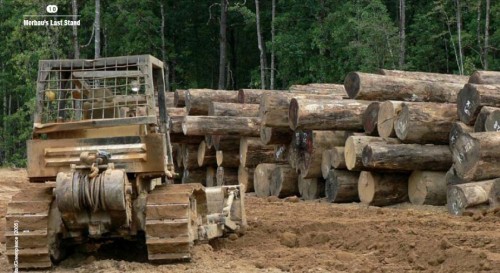
.
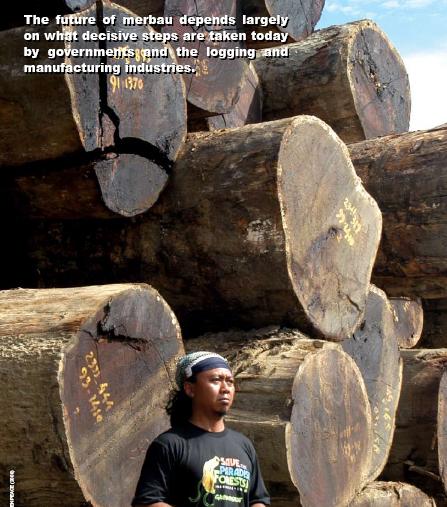
.
.
Rimbunan Hijau Group of Companies
.
“Malaysia’s largest timber group is Rimbunan Hijau (“Forever Green”) (Forbes, 1995). It has timber concessions in Sarawak of around 800,000 hectares (FT,1994), dominates Papua New Guinea’s forestry sector and has forestry interests in New Zealand and China, as well as diversifying into other activities such as the ownership of newspapers in Malaysia and Papua New Guinea (AsiaMoney, 1995). Rimbunan Hijau also owns a 40% share in Limgang Trading Sdn., which has a 310,000 hectares concession in Sarawak (55% of Limbang is owned by Sarawak’s Minister for the Environment and Tourism, James Wong Kim Min) It is privately owned and controlled by one family, headed by Tiong Hiew King. The family are estimated to be worth about US$2.5 billion (Forbes, 1995).”
“Whilst it remains largely a private group of companies, whose operations are veiled in secrecy, the Tiong family has sought to obtain a more public face through the reverse take-over of Berjaya Textiles Bhd (now renamed Jaya Tiasa Holdings Bhd), giving it a listing on the Kuala Lumpur Stock Exchange (FT 1994). Its overseas logging operations appear to remain under the control of the private parts of the group and in Papua New Guinea it is the dominant player through control of a number of associate and subsidiary companies. There are recent rumours that Rimbunan Hijau group owns, or is in the process of acquiring, Primegroup Holdings, a British Virgin Islands registered company with logging interests in Guyana and Papua New Guinea. If this is true, then Rimbunan Hijau group’s international logging interests are, or will shortly become, even more extensive, both geographically and in terms of size. Apart from its logging activities, the company has interests in banking, newspapers and oil-palm plantations. One of Hiew King’s younger brothers is a member of the Malaysian Parliament. Despite the company’s political connections, it has been caught for tax evasion, the Asian Wall Street Journal reported.”
.
[Source: Greenpeace, 1997, http://archive.greenpeace.org/comms/97/forest/asian_companies_malaysia.html, accessed 20110325].
.
“Rimbunan Hijau is a Malaysian based global forest logger and controls around 60% of the forest industry in Papua New Guinea. Rimbunan Hijau is Logging vast areas of virgin PNG forest against national opinion and local customs which infringes on the traditional rights of indigenous resource owners.
- (It is) accused in PNG Government reports of gross human rights abuses, labor abuses, sexual abuses and illegal logging.
- Causing destruction of ancient natural forest and associated systems.
- Conducting broad scale industrial logging operations that infringe on the rights of local people to establish and exploit alternative economic opportunies.
- Is influencing political and other processes to gain and maintain a near monopoly on PNGs forest resources and avoid adequate scrutiny and monitoring of its operations.
- Rimbunan Hijau uses the media to promote its operations to the PNG public – Rimbunan Hijau already OWNS The National newspaper and LEGAL THREATS against their only competitor, the Post Courier, have left it wary of criticising Rimbunan Hijau. These have been the only two print media outlets since The Independent was closed down.”
.
[Source: http://www.forestnetwork.net/rhw/]
.
Rimbunan Hijau is ultimately 50% owned by the Boral “Group” of Australia and 50% by Caltex.
[Source: http://www.scribd.com/doc/24211537/2258-Christchurch-New]
.
…so when Australians and New Zealanders buy Merbau timber from local timber yards, hardward stores and furniture retailers – they are driving South East Asian old growth rainforest deforestation.
.
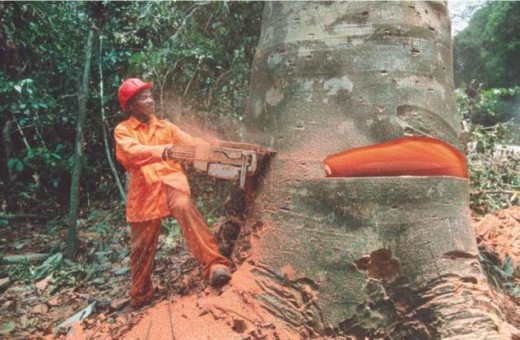
.
.
(The following article from The Guardian in February 2011 is by forests officer for WWF Indonesia, Jimmy Bond, based in West Kalimantan on the island of Borneo)
.
Complacency over deforestation pushes orang-utan closer to extinction
.
“Illegal logging and hunting continues despite legal protection, so the WWF is raising awareness to help save the orang-utan.
The destruction of the world’s rainforests continues at an alarming rate. Where I’m from in Borneo, illegal logging, coupled with hunting, is driving species such as the orang-utan ever closer towards extinction.
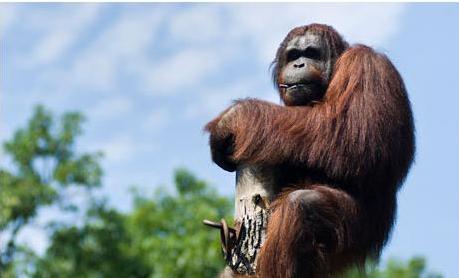 Borneo male orang-utan Wandoo.
There are fewer than 2,000 wild orangutans left in the West Kalimantan province, Indonesia.
©Photograph: Attila Balazs/epa/Corbis Borneo male orang-utan Wandoo.
There are fewer than 2,000 wild orangutans left in the West Kalimantan province, Indonesia.
©Photograph: Attila Balazs/epa/Corbis
.
There are three subspecies of orangutan in Borneo and we only have about 2,000 orangutans left in the wild in West Kalimantan province, and through deforestation and hunting their numbers continue to fall. Just last month I heard from villagers that some people are still killing and eating them even though they’re supposed to be protected by law.
I’ve just been travelling around the region in this part of Indonesia as I’ve been running a series of summer schools as part of a WWF awareness campaign to highlight the problems facing the orang-utan.
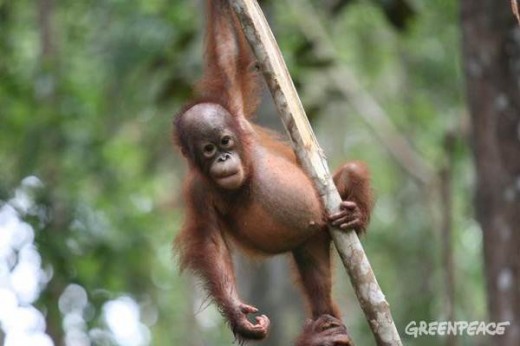
Over the past two years, the main focus for the campaign has been children because we’ve found it very difficult to change the minds and attitudes of older generations. We invite the kids to come along to these camps from nearby villages and at the last one more than 200 kids turned up. We do many different activities from drawing to tug-of-war competitions but the over-arching aim is to touch their hearts with stories about this wonderful creature and the rainforests in which they live. We want to leave them with the understanding that these unique creatures need protecting.
We’re also starting to join forces with local government officials and religious leaders to spread the message to communities that live in traditional longhouses. We tell them about a recent success story that acts as a warning against killing orang-utans. One trader in Pontianak, where I’m based, was recently jailed for two years for trading orang-utans.
Such discussion also helps us talk about their habitats and the need to protect them too. In West Kalimantan from 1995, large-scale illegal logging cut through a forest corridor that linked two national parks where one of three subspecies of orang-utan (Pongo pygmaeus pygmaeus) lives. This meant they couldn’t migrate between the two areas and their numbers dropped significantly. This was made worse because the illegal loggers who came here to work also hunted meat from the forests and the orang-utans were in the firing line.
Over the past few years we’ve been trying to highlight these problems to the international media because some of the illegally logged timber was transported over the border to Malaysia where it is made into wood products that are shipped all over the world. Globally, we want people to become educated about where the timber that makes their furniture comes from and the harm it is doing to species and communities. When the forest disappears people no longer have access to food and medicines plus we have also seen more flooding as a result of deforestation. The international media focus also helps push our government to react because not so long ago they were doing nothing to help.
Recently, we’ve seen companies get permits from the government to develop palm oil plantations. But what’s worse is that the permits are just a smokescreen for the companies to get at the timber and leave without planting any palm oil.
So we’re working to make indigenous communities aware of this practice and the best way to do this is by bringing in others who have seen this happen on their land to warn them. If they are forewarned then they know not to allow it to happen to their own communities. These people need to have the forest in good condition because it’s not only home to different species, it’s also where they earn their livelihood.
Looking to the future, my big ambition is to set up an orang-utan rehabilitation centre here in West Kalimantan for subspecies Pongo pygmaeus pygmaeus. At the moment, orphaned babies are taken to other parts of the country where they are kept with the two other subspecies. I want them to be able to breed with their own kind otherwise they could die out. And I fear that if the orangutan disappears, the rainforest won’t last much longer either.”
[Source: The Guardian newspaper (UK) , http://www.guardian.co.uk/environment/blog/2011/feb/03/indonesia-deforestation-orangutan-extinction, accessed Feb 2011]
.
.
Further Reading
.
http://www.nps.gov/seki/historyculture/gfgst.htm
http://en.wikipedia.org/wiki/Intsia_bijuga
http://www.indonesianrainforest.org/irf-news/373-campaign-against-kwila-imports-continues-.html
http://rainforest-action.blogspot.com/2010/09/end-sales-of-kwila-timber-products.html
http://www.greenpeace.org/new-zealand/en/press/illegal-kwila-timber-imports-f/
http://www.info-ri.com/indonesia/rainforest-action-end-sales-of-kwila-timber-products/
http://www.robcousens.com.au/files/D512143129.pdf
http://www.dansson.com/kwila.htm
http://www.greenpeace.org/international/Global/international/planet-2/report/2008/7/merbau-report-2.pdf
Greenpeace, 1997, http://archive.greenpeace.org/comms/97/forest/asian_companies_malaysia.html
http://www.coolearth.org/306/whats-new-32/news-155/illegal-logging-threatening-malaysian-wildlife-453.html
http://www.wwf.org.my/media_and_information/wwf_position_statements/?5741
http://www.ewp.asn.au/certification/certificationcoc.html
http://www.forestnetwork.net/rhw/
http://www.atif.asn.au/
http://www.scribd.com/doc/24211537/2258-Christchurch-New
http://www.baddevelopers.green.net.au/Docs/talltrees.htm
The Guardian newspaper (UK) , http://www.guardian.co.uk/environment/blog/2011/feb/03/indonesia-deforestation-orangutan-extinction
.
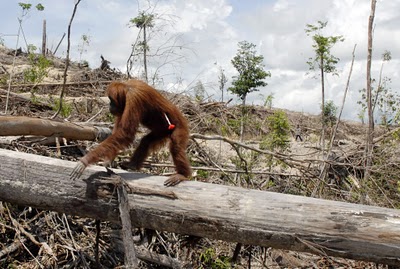 . .
Tags: Boral Group, Californian redwood, Caltex, commercial logging, deforestation, Earth's Pathogen, Eucalyptus regnans, Ferguson Tree, General Sherman Sequoia, Giant Forest, giant redwood, Guam, hallowed majesty, human pathogen, illegal logging, Intsia bijuga, Janka rating, Kalimantan, Kwila, Merbau, merbau flooring, Merbau's last stand, Narra, Neerim, old growth conservation, old growth forest, orang-utan, orang-utan extinction, Oregon, Primegroup Holdings, Rainforest Kwila, Rimbunan Hijau, San Joaquin Valley, Sarawak, Sequoia sempervirens, Sequoiadendron giganteum, Sierra Nevada, significant trees, world's largets tree, Yakal
Posted in 31 Old Growth Conservation!, Congo (CD), Kalimantan (ID), Sumatra (ID), Threats from Deforestation | No Comments »
Add this post to Del.icio.us - Digg
Thursday, March 24th, 2011
 Golden Bandicoot is under threat of extinction in The Kimberley. Golden Bandicoot is under threat of extinction in The Kimberley.
.
“Australia has the worst extinction record for mammals of all countries in the world (Johnson 2007), and has international obligations (Convention on Biological Diversity 2006) and national commitments (Commonwealth of Australia 1999) to avoid species extinctions. Meeting these obligations will require effective and ongoing conservation management.”
[Source: Priority threat management to protect Kimberley wildlife, p47,CSIRO Ecosystem Sciences, Feb 2011, Australia]
.
.
.
At 6am on 1st June 1990, I started my prepared and serviced HT Holden outside my father’s place in Melbourne and executed my planned drive mission across to Adelaide then up the Centre to Kununurra in the East Kimberley. I was 26; I had saved up. I was on a mission to get my commercial helicopter license and to work in cattle mustering in the Kimberley in the process to ‘get my hours up’.
The Kimberley was a very hot and steamy; a world away from temperate urban Melbourne.
Well, after some months and growing up in a remote landscape, I did achieve my license with Golden West Helicopters, then did some mustering. I took risks, recalling pivot turns over isolated beaches and I learnt a lot…what city kids should.
Some memories that will remain with me (until my memory doesn’t) are the waking to East Kimberley bird calls from the pilot shack at the red dusty caravan park down the road from Kununurra Airport. When building my cross-county and low-level endorsement hours up, I will never forget flying the R22 low over wild rivers full of long lizards (crocs), or slowly navigating the thick mist at 50 foot AGL at dawn, or flying free over the wide rugged red rock landscape, or finding the eagles nest on a remote hill miles off in some north westerly direction from Kununurra. My memory of the Kimberley is of a wild special place, like Emma Gorge and the amazing remote drive to Wyndham – so isolated – so free. But it is the unique bird calls that recur in my memory of the magic natural tropical home of The Kimberley.
So when I now later learn that the Kimberley and its scarce wildlife are under threat, I have no hesitation posting the following article to advocate the urgency of the Kimberley’s wildlife conservation.
The Kimberley is indeed like nowhere else!
~ Editor
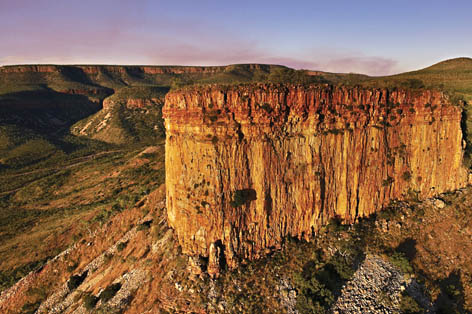
.
.
According to the findings of a current ecological study and report published in February 2011 by the CSIRO and The Wilderness Society:
“up to 45 native species in the Kimberley region will die out within 20 years if no action is taken”.
.
The report found that the two most destructive threats to survival of native species are:
-
Feral cats
-
Frequent large scale fire regimes (deliberate or neglected)
.
It has called for an immediate cash injection of $95 million to save wildlife like the Golden Bandicoot, the Scaly-tailed Possum and the Monjon Rock Wallaby from extinction. Even with the current $20 million per year spent on Kimberley conservation the region is still set to lose some 31 native animals, according to the report.
The report is a culmination of collaborative ecological research and workshops was undertaking across the Kimberley region by scientists with the CSIRO’s Ecosystem Sciences, along with The Wilderness Society, Australian Wildlife Conservancy, Fenner School of Environment and Society (ANU), and The Ecology Centre at the University of Queensland. Its authors from these organisations include Josie Carwardine, Trudy O’connor, Sarah Legge, Brendan Mackey, Hugh Possingham and Tara Martin. Regrettably, the only contributing organisations permanently based in the Kimberley appear to be the Kimberley Land Council and Environs Kimberley. Perhaps this is half the problem; the other half being ye ol’ lack of political will, because surely Australia has plenty of taxpayer funds in circulation.
If ever the ecological precautionary approach principle was a vital precondition of human actions, the Kimberley is the place where it most applies. The recurring theme throughout the report is the lack of comprehensive survey data from the region. Ecologically, the Kimberley is grossly data deficient. Consequently, humans know not what they do, nor what the impact of what they do is, nor how close the thirty odd threatened and endangered native animals are to regional extinction.
The Scaly-tailed Possum (Wyulda) , Monjon Rock Wallaby and the Cave-dwelling Frog are thought to be uniquely endemic to the region, so if they are wiped out from the Kimberley, as a species they will become globally extinct, like the Tasmanian Tiger (Thylacene) and the Dodo.
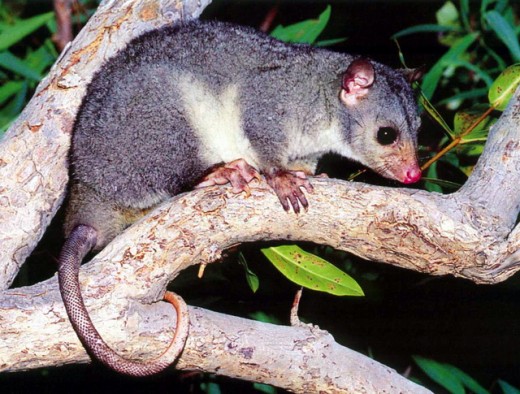 Wyulda, or Scaly-tailed Possum (Wyulda squamicaudata)
endemic to the Kimberley, and highly sensitive to bushfires Wyulda, or Scaly-tailed Possum (Wyulda squamicaudata)
endemic to the Kimberley, and highly sensitive to bushfires
.
Due to human encroachment and habitat destruction across northern Australia and the ferals and destructive practices they have brought with them, the still mainly wild Kimberley remains the last survival refuge for many of Australia native at-risk species.
Native vertebrate fauna of the Kimberley like the Northern Quoll, Golden-backed Tree-Rat, Golden Bandicoot, Gouldian Finch, Spotted Tree Monitor, Western Chestnut Mouse, and Stripe-faced Dunnart are at serious risk of extinction.
.
Priority Threat Management Actions for The Kimberley
.
Experts identified key broadscale threat management actions for improving wildlife persistence (p5):
1. Combined management of fire and introduced herbivores! – feral donkeys, cattle, horses, pigs
2. Eradication, control, quarantine of weeds! – rubber vine, gamba grass, mesquite, passionfruit
3. Control of introduced predators! (particularly feral cats)
.
“The single most cost-effective management action would be to reduce the impacts from feral cats (at $500,000 per bioregion per year) with a combination of education, research and the cessation of dingo Baiting.” [p.6-7]
.
While anticipated to have low feasibility of success, the feasibility has not been started nor tested.
“The next most cost-effective action is to manage fire and introduced herbivores (at $2–7 million per bioregion per year); this action is highly feasible and, if implemented effectively, would generate large improvements in probabilities of persistence for almost all wildlife species.” [p.6-7]
.
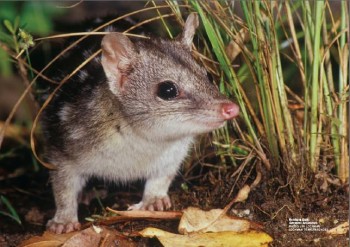 Northern Quoll (Dasyurus hallucatus)
Native to the Kimberley, but seriously at risk from feral cats and bushfires Northern Quoll (Dasyurus hallucatus)
Native to the Kimberley, but seriously at risk from feral cats and bushfires
.
.
Natural Integrity and (Human) Threats
.
.
Threats to The Kimberley from ‘Bushfire Management’
.
“Frequent, extensive and very hot fires in the Kimberley affect its ecosystems in several ways. They change the structure and composition of vegetation, endangering some species of plants and removing important wildlife habitat refugia. They also leave the ground unprotected from the heavy monsoonal rains, causing soil erosion and later stream sedimentation.”
Inappropriate fire regimes pose a threat to biodiversity in the Kimberley and across northern Australia (e.g. Bowman et al. 2001; Russell-Smith et al. 2003). Historically, Indigenous people managed fire throughout the region, which included fine scale prescribed burning across a variety of vegetation types and around important cultural and food resource sites, such as rainforest patches. This most likely resulted in a mosaic of burnt and unburnt vegetation and provided buffers against unplanned wildfires around critical biodiversity refuges (Environmental Protection Authority 2006).

Broadscale State-sanctioned Arson of the Kimberley
(Photo: Ed Hatherley, Western Australia Department of Environment and Conservation)
[Source: ^http://www.australiangeographic.com.au/journal/new-fire-plan-for-the-kimberley.htm]
.
These fire patterns have been replaced in the past few decades with one that is increasingly dominated by extensive and intense mid to late dry season fires. As a consequence, the mean age (and variance) of the vegetation has declined (Legge et al. 2010).
Altered fire regimes interacting with other degrading processes, especially over-grazing, have led to structural and floristic change in vegetation, declines in vegetation cover and critical resources such as tree hollows. They are also associated with increased soil erosion after heavy rains (doubled erosion rates have been recorded in similar situations in the Top End of the Northern Territory (Townsend and Douglas 2000), leading to increased sedimentation in stream beds. These changes have severe negative impacts on native flora and fauna (Vigilante and Bowman 2004; Legge et al. 2008). Extensive flat savanna areas are more vulnerable to large intense fires, as there are fewer inflammable refugia such as rocky areas.
Without appropriate management, the impacts of fire are likely to increase as the region is predicted to become even more fire prone with ongoing climate change (Dunlop and Brown 2008)”. [pp.11-12]
.
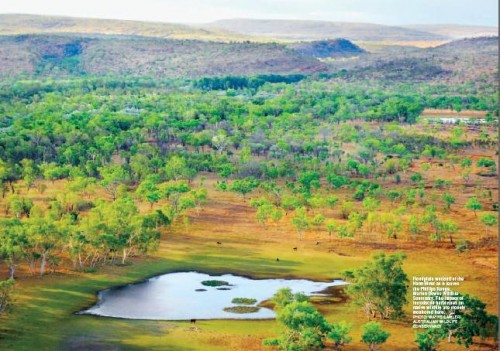 Floodplain wetland of the Hann River
as it leaves the Phillips Range,Marion Downs Wildlife Sanctuary, The Kimberley.
© Photo by Wayne Lawler, Australian Wildlife Conservancy Floodplain wetland of the Hann River
as it leaves the Phillips Range,Marion Downs Wildlife Sanctuary, The Kimberley.
© Photo by Wayne Lawler, Australian Wildlife Conservancy
.
.
Threats to The Kimberley from ‘Feral Cats’
.
“Invasion by feral predators has contributed to range reductions and population declines of many native animals in Australia; small to medium sized mammals have been particularly affected. The primary feral predator in the Kimberley is the domestic cat. Cats have possibly been present in the region since the 1880s and were established by the 1920s (Abbott 2002).
The number of cats occurring in the Kimberley is unknown due to difficulties in survey, although a radio-tracking study at Mornington Wildlife Sanctuary suggests there is one individual per 3 km², each eating 5–12 native vertebrates daily. If this population density of cats occurred throughout the region there would be over 100,000 individuals present, consuming at least 500,000 native animals every day (Legge unpublished data).
There is some evidence that dingoes, as a top predator, can help control the negative effects of smaller predators like foxes and cats (Glen et al. 2007; Johnson and VanDerWal 2009; Letnic et al. 2010; Kennedy et al. 2011). The regular baiting of dingoes is therefore likely to exacerbate the problem of introduced feral predators (Wallach et al. 2010).” [pp.13-14]
 Cat killing wildlife
[Source: Australian Wildlife Carers Network, ^http://www.ozarkwild.org/cats.php,
Photo: Australian Government] Cat killing wildlife
[Source: Australian Wildlife Carers Network, ^http://www.ozarkwild.org/cats.php,
Photo: Australian Government]
.
“The Kimberley is a national priority in this effort to avoid further extinctions due to its intact suite of wildlife species, including many endemics, and its role as a refuge for an increasing list of species that are declining or have been lost in other areas of northern Australia.” [p.47]
.
.
Further Reading on Kimberley Conservation:
.
[1] Carwardine J, O’Connor T, Legge S, Mackey B, Possingham HP and Martin TG (2011), Priority threat management to protect Kimberley wildlife , CSIRO Ecosystem Sciences, CSIRO Australia, Brisbane, and The Wilderness Society, (76 pages), ISBN 978 0 643 10306 1, http://www.csiro.au/resources/Kimberley-Wildlife-Threat-Management.html
[2] ‘Australia to lose 45 species in 20 years’, 20110323, AAP, http://www.smh.com.au/environment/australia-to-lose-45-species-in-20-years-20110322-1c5bx.html
[3] Marion Downs Sanctuary (Kimberley), Australian Wildlife Conservancy, http://www.australianwildlife.org/AWC-Sanctuaries/Marion-Downs-Sanctuary.aspx.
[4] Mornington Sanctuary (Kimberley), Australian Wildlife Conservancy, http://www.australianwildlife.org/AWC-Sanctuaries/Mornington-Sanctuary.aspx
[5] Kimberley Land Council, http://klc.org.au/
[6] Environs Kimberley, http://www.environskimberley.org.au/
[7] Kimberley Australia, http://www.kimberleyaustralia.com/kimberley-environment.html
[8] Save the Kimberley, http://savethekimberley.com/blog/?tag=kimberley-environment-development-conservation
[9] Save the Kimberley, http://www.savethekimberley.com/wp/tag/kimberley-environment-development-conservation/
[10] The Wilderness Society, http://www.wilderness.org.au/campaigns/kimberley/northern-australia-taskforce-recognises-kimberley-environment-must-be-protected
[11] The Kimberley – Like Nowhere Else, http://www.likenowhereelse.org.au/what_needs_to_be_done.php
[12] (Government site) West Kimberley National Heritage assessment, Australian Heritage Council,
http://www.environment.gov.au/heritage/ahc/national-assessments/kimberley/index.html
[13] Kimberley Foundation Australia (KFA), http://www.kimberleyfoundation.com
.

.
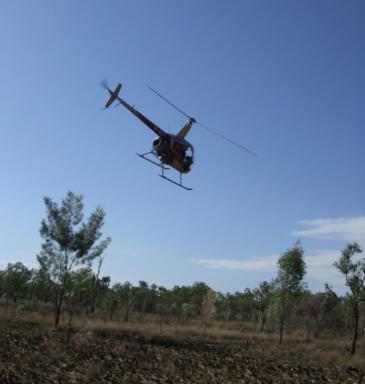
– end of article –
https://www.habitatadvocate.com.au/?page_id=13848
Tags: Australian wildlife, Cave-dwelling Frog, conservation, CSIRO, Golden Bandicoot, Golden-backed Tree-Rat, Gouldian Finch, Kimberley, Monjon Rock Wallaby, Northern Quoll, Priority threat management, Scaly-tailed Possum, Spotted Tree Monitor, Stripe-faced Dunnart, The Wilderness Society, threat management, Western Chestnut Mouse, Wyulda
Posted in Bandicoots, Kangaroos and Macropods, Kimberley (AU), Mice (native) and Antechinus, Possums and Gliders, Quolls, Reptiles, Threats from Bushfire, Threats from Colonising Species | No Comments »
Add this post to Del.icio.us - Digg
Friday, March 4th, 2011
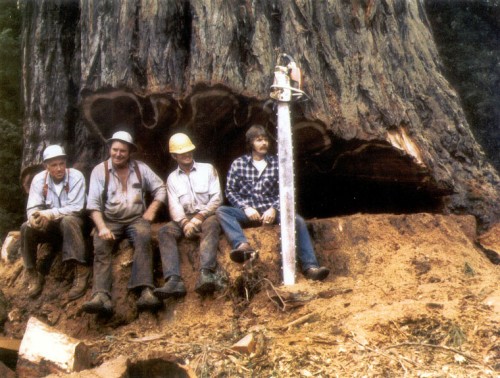 Gunns’ must really be loaded to commit $2.2 billion on a pulp mill in Tasmania’s Tamar Valley. Gunns’ must really be loaded to commit $2.2 billion on a pulp mill in Tasmania’s Tamar Valley.
Not many companies have that sort of money and certainly not in cash-strapped Tasy. But with access to so much financial capital, why waste it on 20th Century logging? Tasmania has so much economic potential using 21st Century thinking and think what a smart $2.2 billion could otherwise benefit Tasmania’s future, without 19th Century exploitation?

The money to build such a pulp mill has to come from somewhere and it appears Gunns’ may have found a financial joint venture backer in Finnish pulp giant, UPM-Kymmene Oyj.
[Source: ‘Finnish firm UPM eyes stake in Gunns pulp mill‘, by journalist Matthew Denholm, The Australian, 20110209].
Gunns tries to claim that it’s motive is all about forestry jobs for Tasmanians. But once UPM gets a foothold in Tasmania, check UPM’s record with jobs…
.
“In September 2008 UPM announced another cost reduction program that includes layoffs thousands of employees, and its Kajaani paper mill and Tervasaari pulp mill will be closed altogether. These will be the largest layoffs ever in Finland.
In March 2006 UPM announced a cost reduction program that includes layoffs approximately 3,600 employees, nearly 3,000 of those in Finland, and its Voikkaa paper mill in Kuusankoski was closed altogether. This was the largest single layoff ever in Finland. This is attributed[by whom?] to the worldwide overproduction of paper.
UPM announced the permanent closure of a large mill complex in Miramichi, New Brunswick on December 17 2007, citing economic pressures in the North American forest industry.”
[Source: http://en.wikipedia.org/wiki/UPM_%28company%29 ]
.
Greg L’Estrange, Gunns’ replacement CEO for John Gay since July 2009, seems to be tasked with getting the pulp mill up and running no matter what the cost, no matter what spin doctoring efforts are employed to secure government approval. Somehow his deal making has succeeded in government fast-tracking of the assessment process.
.
On 25th November 2010, Gunns released a statement to the Australian Stock Exchange stating that the pulp mill project remained on track. This is Gunn’s ‘do-or-die‘ single corporate strategy. It has no plan B. . L’Estrange’s initial ploy was to remove the motive driving Gunns’ key enemies. Gunns’ declared a moratorium on native forest logging across Tasmania. It was clearly a bid to secure Forestry Standard Certification, to comply with new Japanese buyer benchmarks; rather than any noble recognition of native forest conservation values.
.
Then L’Estrange concocted Gunn’s Forest Statement of Principles and armed with this did a secret forest peace deal late last year with local greenie groups. L’Estrange sold it as a new greener Gunns’ “working with environment groups to create a future without conflict.” Consistent with strategy, the ‘Tassie Talks’ deal it was all about quelling Tasmanian public dissent and he quickly branded the deal pivotal to the Tasmanian forest industry and ‘historic’. Be seen to be green! Whatever it takes! Except environmental groups deny they have given the green light to Gunns Tamar valley pulp mill by signing the deal.  There’s that greenwashing term again – ‘sustainable‘. It’s become an abused and hollow marketing euphemism really about corporate ‘financial viability‘ in the exploitation of natural resources. Such corporations shy from using the term ‘triple bottom line’ any more, because it is harder to promote when one is only focused on the bottom line. And there’s fresh water demand of the mill and the marine effluent it will spew, which L’Estrange has tried to allay concerns claiming new pulp bleaching technology promises to reduced toxic outflow of chlorine dioxide by some 40%. Despite the promise of ‘stricter controls’ an expected 64,000 tonnes of effluent will still be released by the pulp mill into Bass Strait daily. And it won’t harm marine life? There’s that greenwashing term again – ‘sustainable‘. It’s become an abused and hollow marketing euphemism really about corporate ‘financial viability‘ in the exploitation of natural resources. Such corporations shy from using the term ‘triple bottom line’ any more, because it is harder to promote when one is only focused on the bottom line. And there’s fresh water demand of the mill and the marine effluent it will spew, which L’Estrange has tried to allay concerns claiming new pulp bleaching technology promises to reduced toxic outflow of chlorine dioxide by some 40%. Despite the promise of ‘stricter controls’ an expected 64,000 tonnes of effluent will still be released by the pulp mill into Bass Strait daily. And it won’t harm marine life?
‘At its annual general meeting in November, Gunns told shareholders that modelling work showed the mill would have no impact on marine ecosystems, but Environment Tasmania said it was still concerned about the effect of up to 51 gigalitres a year of industrial effluent being discharged into the sea.’
[Source: ‘Promise of greener hue to pulp mill at final hour‘, 20110304]
.
Securing Gunns’ shareholder backing, L’Etrange at Gunns’ recent annual general meeting, drew a line in the sand claiming the moratorium on native forest logging (the greenie forest deal) was now conditional on the Tamar Valley pulp mill going ahead. If the greenies want to keep Tasmania’s native forests, they must agree on the pulp mill proceeding. The ‘Tassie Talks’ deal was always a loaded gunn deal.
“We believe that the development of the Bell Bay Pulp Mill will be the centrepiece of this strategy for the modern industry in Tasmania.”
[Source: ‘Pulp mill key, says Gunns‘, by journalist Sue Neales, 20101125]
.
Of course it’s all rather reminiscent of Gunn’s heavy-handed power playing under John Gay. The Gunns’ Board hasing changed; only its front man. This latest greenwashing approach is one of image rebranding and loaded deals, all the while Gunns’ pulp mill strategy remains on track. L’Estrange plays good cop while the pulp mill unswervingly looms as Tasmania’s big bad cop.
.
Tasmania’s natural heritage is Tasmania’s future… whether dead in a museum like its Thylacene or alive and precious…is ultimately an existence decision for local Tasmanians.
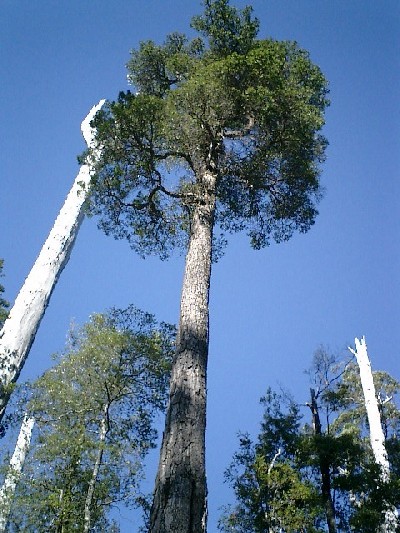 Tasmania’s unique Celery Top Pine
[Source: Veronica Tyquin, WARRA (long-term ecological research)
http://www.warra.com/warra/research_projects/research_project_WRA108.html] Tasmania’s unique Celery Top Pine
[Source: Veronica Tyquin, WARRA (long-term ecological research)
http://www.warra.com/warra/research_projects/research_project_WRA108.html]
.
.
Update News Friday 20110311: ‘Contentious pulp mill wins federal approval’
.
Yesterday L’Estrange must have earned his executive performance bonus following Labor’s federal Environment Minister, Tony Burke, announcing government approval for the pulp mill to proceed. L’Estrange’s comment was that the decision brought certainty for proposed investors in the pulp mill project, now estimated to cost $2.3 billion, pre-cost blowout, pre-government subsidies. (‘Contentious pulp mill wins federal approval’, SMH, 20110311)
.
Upon gaining the final three environmental permits Gunns needs for the mill, Gunns shares rose 5.88% to close at $0.63. (Finnewsnetwork.com.au, 20110311). Certainly a ‘sustainable’ result for L’Estrange.
Gunn’s pulp mill will perpetuate 20th Century logging across Tasmania. It will continue to make Tasmanian rural communities dependent on one industry and vulnerable to the whims of one employer – Gunns.
.
Gunns’ spin is that the mill will only use timber from plantations, capitalising on the fact that those plantations were planted as a result of clear felling destruction of Tasmania’s rare native forests. According to The Wilderness Society, Gunns’ wood supply deal with Forestry Tasmania commits it to supplying a million tonnes a year of native forest for the next twenty years. (‘Gunns’ proposed pulp mill, The Wilderness Society, 20110310)
.
So Gunns’ ‘plantation only’ claim is false and misleading.
.
The mill will spew odorous fumes downwind through the Tamar Valley forcing thousands of residents of this rural region to breathe polluted and toxic air and contaminate local horticultural producers such as vineyards. The mill is forecast to consume fresh water equivalent of the combined use of all water users across Northern Tasmania, according to The Wilderness Society there. (‘Gunns’ pulp mill impacts – Environment, heritage, economy and community threatened, The Wilderness Society, 20100530).
.
Gunns’ mill is still set to spill 64,000 litres of toxic chlorine, dioxins and furans a day from its chemical pulping process into the Tamar River and downstream into Bass Strait. That it will obviously pollute the surrounding waters, kill marine wildlife, poison and permanently contaminate marine habitat, and destroy the local fishing industry; Burke has still managed to find a way to approve the bloody mill!
“I’m only doing what my requirements are under the Act. We’ve got some very specific requirements on environmental approvals. I’m delivering on that.” – Tony Burke. (‘Milne: Pulp mill approval a corrupt process’, ABC TV Lateline, 20110310)
Burke in the same week, managed to push through legislation to allow Sydney’s Barrangaroo development avoid the cost of a heavy metals clean up, while at the same time stuck to the letter of the law with his approval of Gunns’ pulp mill. Can there be no clearer display of pro-development bias? Laws for some!
But then Burke’s bias is predicable, given he came to the portfolio from the other side of the fence, as Minister for Agriculture, Forestry and Fisheries; and his quick rise from the NSW right faction. (‘Gunns deal a shedding of responsibility, by Andrew Darby, The Age, 20110311)
According to federal Greens Senator Christine Milne responding on last night’s Lateline programme:
“There has never been a thorough and rigorous assessment (of the pulp mill) because Paul Lennon, former Premier of Tasmania together with John Gay, managed to pull it out of the proper assessment process (at State level), fast-track it through the Tasmanian Parliament…so what we have got here is a project that has been through a corrupt assessment process.”
Milne is factually correct. There was no rigorous assessment of the Bell Bay site. The Tasmanian assessment process was corrupt, the community was denied a say, the democratic process was abused. The mill has no social license to operate. It is illegitimate and Gunns’ development actions are one of a corporate and political bully imposing its selfish shortsighted greed on Tasmania and Tasmanians.
.
Gunn’s Bell Bay pulp mill will not only degrade the region, but dominate the northern heart of Tasmania. On Google Earth it will show up like a festering sore poisoning a diminishing green forested Tasmania.
L’Estrange borrowed Labor’s classic dirty tactic of divide and conquer to stymie opposition and protests from Tasmanian conservation groups. His deal has seeded a split between conservationists and the Greens over the pulp mill. He has lured local conservationists to compromise with the offer to surrender Gunns’ contract rights to 220,000 cubic metres of native forest saw logs a year and to protect an extra 600,000ha of forests. Even Labor’s appointed negotiator Bill Kelty has been brought in to clench a forest peace deal with select conservationists. The Wilderness Society in Tasmania, together with Environment Tasmania and the Australian Conservation Foundation seem to be coming on board backing down on their opposition to the pulp mill. They are now at odds with the Tasmanian Greens who are a little more savvy about the hollow politics and promises.
“It looks as though somebody wants to save some high conservation value forests, but is sacrificing the Tamar Valley to get them”, says Tamar Valley resident and mill opponent Peter Cundall. (Greens v Greens on Gunns pulp mill, The Australian, 20110304)
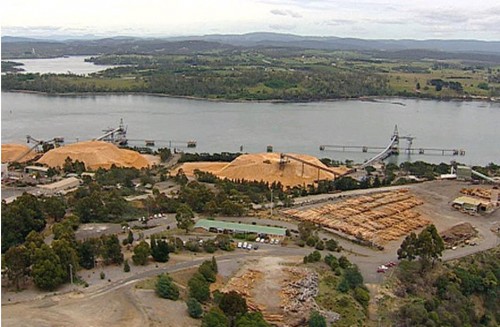 Site of proposed Gunns’ pulp mill, Bell Bay, Tamar Valley
Photo: http://www.abc.net.au/news/stories/2011/03/10/3160890.htm Site of proposed Gunns’ pulp mill, Bell Bay, Tamar Valley
Photo: http://www.abc.net.au/news/stories/2011/03/10/3160890.htm
.
.
.
The editor agrees with the following selected comments posted in The Australian to the article ‘Greens v Greens on Gunns pulp mill, 20110304:
.
By James McMaugh’:
“The mill will never be built. The people are opposed and are right not to trust Gunns. There will be a huge outcry and mass protests blockading construction. I will travel to Tasmania and so will many others to make sure of this. The proposal is dead.
It’s about time politicians listened to the people and business should too. You cannot run roughshod over the will of the people and they don’t want this mill. Overwhelmingly they don’t. It will cost more jobs than it creates and destroy the river. No, no and no to this mill.”
.
By ‘Chris B of Australia’:
“The only acceptable outcome is NO Pulp Mill at all in Tasmania. Gunns has no credibility and has proven time and again how they cannot be trusted by the community. I personally believe there is no place for a company like Gunns in Tasmania and they should make transition plans for their workforce to move to a sustainable industry.
The environmental groups willing to compromise the values and allow Gunns to sacrifice the Tamar Valley should be ashamed of themselves. Make no mistake, the pulp mill will completely and utterly degrade the environment of the Tamar Valley and Bass Strait, no matter which form it takes.”
.
By ‘SW’:
“ Senator Milne speaks for me. Thank you, Christine, for maintaining the rage. It certainly hasn’t died down here in the Tamar Valley.”
.
By ‘Robert of Adelaide’:
“ Same old argument of lack of development, growth, jobs, high crime etc. The same attitude is taken in the case of the Brazilian Rainforest as well. Where does it stop and what will we actually be left with in 100 years? Oh, that’s right, we won’t be here, so who cares… If people want employment, go to where the jobs are in the rest of the country and the world like everyone else is doing! And while you are working in places like Sydney, London, Beijing, Tokyo and Bangkok… reflect on how wonderful development has been for these these concrete infested cities! Then maybe we can appreciate what we have here.”
.
.
.
‘Green movement outguns Gunns’ [20110311]
.
…’Gunns had gone so far as to sue an elected politician, the Greens leader, Bob Brown.
“When I got the writ,” says Brown, “I knew better than to call the lawyers. The first thing I did was to call a press conference. Within 24 hours we had a candlelight vigil for democracy, in Hobart. It was like the Prague Spring.”
Ultimately, Gunns underestimated its opposition and its decision to sue backfired spectacularly.
Far from being cowed by the suit, Marr and his colleagues ramped up an environmental campaign the likes of which had not been seen in this country – targeting the Gunns bankers and shareholders, Japanese customers and European partners – which ultimately brought the company to its knees, decimating its market value and ousting its divisive chairman, Gay.
.
..It was left to the new chief executive, Greg L’Estrange, to concede defeat last September, and promise that Gunns would get out of native forest logging altogether. Despite this week’s federal approval of the mill, and the talks over a Tassie forests peace deal, Gunns is by no means out of the woods. A long, painful process of rebuilding trust with former enemies is only beginning.
.
Gunns was once a corporate powerhouse. A series of acquisitions in 2000-01 turned it into Australia’s largest export woodchipper, and No. 1 target for the environment movement.
..’A bulked-up Gunns put the pedal to the metal. This was logging on an industrial scale. Between 2000 and 2006, working with Forestry Tasmania, Gunns clear-felled 110,966 hectares of native forest, 90 per cent of the timber being used for woodchipping and 58% of the land making way for timber plantations.
“Gunns got unlimited amounts of other people’s money and went on a clearing binge,” says Marr.
The forest was clear-felled and waste burnt off using napalm-like incendiaries. Gunns used 1080 poison bait to protect seedlings, inflicting gruesome death on untold native animals and risking the health of forest workers.
.
Whether from strength or desperation, Gunns launched its ill-fated suit. The company’s shares hit their all-time peak a month later, at $4.38, and began to slide downwards. The story of the Gunns 20 suit, which dragged on until last year and was ultimately settled at a cost to the company of $2.8 million – including $1.3 million paid to the Wilderness Society – has been well told. Perhaps less well understood is the international backlash the case triggered.
The decision in 2008 by the new ANZ chief, Mike Smith, to refuse finance for the pulp mill, quickly followed by the other big banks, was unprecedented in this country and followed a strong online petition campaign by the Wilderness Society and the online activist group GetUp!After a decade’s lobbying, Japanese paper-makers decided in February last year not to accept Gunns wood unless it was Forest Stewardship Council- controlled.
.
Shares in Gunns are off their lows but the company’s future remains uncertain. Bob Brown says if Gunns ”doesn’t survive – and I hope it does – it will be nobody’s fault except the board’s”.
.
[Source: ‘Green movement outguns Gunns, by Paddy Manning, Sydney Morning Herald, News Review, p 6,
http://www.watoday.com.au/national/green-movement-outguns-gunns-20110311-1br8m.html]
.
References
.
[1] ‘Contentious pulp mill wins federal approval’, by Andrew Darby and Dylan Welch, 20110311, Sydney Morning Herald, http://www.smh.com.au/environment/contentious-pulp-mill-wins-federal-approval-20110310-1bpt4.html]
.
[2] ‘Gunns’ proposed pulp mill’, The Wilderness Society, 20110310, http://www.wilderness.org.au/campaigns/gunns-pulp-mill
.
[3] Greens v Greens on Gunns pulp mill, by Matthew Denholm and Matthew Franklin, The Australian, 20110304, http://www.theaustralian.com.au/national-affairs/greens-v-greens-on-gunns-pulp-mill/story-fn59niix-1226015622300
.
[4] http://www.finnewsnetwork.com.au/archives/finance_news_network17216.html
.
[5] Photo: http://www.abc.net.au/news/stories/2011/03/10/3160890.htm
.
[6] http://www.watoday.com.au/national/green-movement-outguns-gunns-20110311-1br8m.html
– end of article –
Tags: Alec Marr, Bell Bay Pulp Mill, chlorine dioxide, Forestry Standard Certification, FSC, greenwashing, Gunns, logging industry, native forests, Tamar Valley Pulp Mill, Tasmania, Tassie Talks, triple bottom line, United Paper Mills Ltd, UPM, UPM-Kymmene Group, wilderness
Posted in Tasmania (AU), Threats from Deforestation, Threats from Greenwashing, Threats to Wild Tasmania | 1 Comment »
Add this post to Del.icio.us - Digg
Wednesday, February 16th, 2011
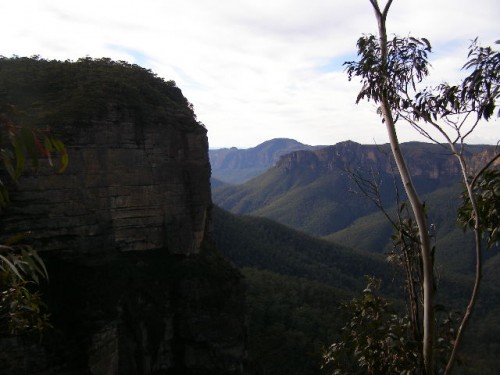 Grose Valley in the Blue Mountains World Heritage Area
..owes its initial salvation to legendary trail blazers Alan Rigby, Myles Dunphy and others of the Sydney Bushwalkers Club in 1931,
who saved the Blue Gum Forest from the threats from farming destruction.
[Photo by Editor 20060625, free in public domain]
. Grose Valley in the Blue Mountains World Heritage Area
..owes its initial salvation to legendary trail blazers Alan Rigby, Myles Dunphy and others of the Sydney Bushwalkers Club in 1931,
who saved the Blue Gum Forest from the threats from farming destruction.
[Photo by Editor 20060625, free in public domain]
.
“We cannot really live for commerce alone, nor will our civilisation be deemed great until we thoroughly recognise the fact that the bushlands and all they naturally contain are gifts of Nature far transcending in value all monetary and commercial considerations.
The humanising gifts of Nature are necessary for our interest, education, adventure, romance and peace of mind.
They constitute the antidote for the evils of our semi-artificial existence. As we destroy our bushland environment we destroy just so much of ourselves. The balance of Nature is finely adjusted: upset it, and there will be a desert at our doors.
All the glory of the canyons, caves and rolling plateau of our great Blue Mountains is not nearly so much a commercial asset as it is Nature’s heritage for legitimate enjoyment, and our own gift to prosperity.”
[Myles J. Dunphy, The Katoomba Daily, Friday 24th August, 1934].
.
Back on Saturday 28th May 2005, the editor was privileged to participate in a special day to farewell Myles Dunphy’s son, Milo Dunphy. Made welcome by the Dunphy family and close friends, I shared a special trek into the outer Blue Mountains wilderness and celebrate scattering the ashes of Milo Dunphy back into his wilderness home of the Blue Mountains.
Despite being blown by chilling winds and under a big blue Australian sky, our dedicated group persisted along a remote, little known foot track up to Kanangra Tops. For Milo the man and the legacy, we arrived in pristine wilderness as far as the eye could see, all thanks to Milo’s life campaign to protect it.
Milo Dunphy lead an environmental cause since the 1960s, saving Colong Caves, the Kanangra, the Komung, the Boyd, the Grose. Milo was the catalyst for what we are all now thankfully able to appreciate from the many trails and lookouts throughout The Greater Blue Mountains World Heritage Area. The legacies of the life works of Myles Dunphy and his son Milo deserve recognition and celebration.
Friday, February 4th, 2011
The local Blue Mountains Gazette newspaper of the Blue Mountains (west of Sydney) yesterday reported the harming of wildlife in the Blue Mountains National Park (read below).
.
$100 REWARD
Disgusted at this wildlife crime, the editor is offering a one-off reward of $100
for the identification of the offender(s) responsible for this wildlife bashing
and its reporting to the National Parks and Wildlife office at Blackheath, which secures a conviction.
.
Contact the editor : info@habitatadvocate.com.au
.
.
‘Snake bludgeoned at Blackheath‘
by Krystyna Pollard (journalist), 20110202, page 11.
.
‘National parks officers have condemned the brutal bludgeoning of a female (eastern) brown snake carrying 19 eggs at Blackheath’s Evans Lookout.
The snake was found on January 13 by a member of the public in her nest alive but with a broken back, according to National Parks and Wildlife Service (NPWS) ranger Vanessa Richardson.
“This brown snake had lived in the vicinity of Evans Lookout for over five years and lived harmoniously with many visitors who appreciated observing her in the natural environment,” she said in a statement.
“She was well known to NPWS staff and many tour operators enjoyed taking visitors to the site to see a real Australian snake in the wild.”
The snake was taken for treatment, however vets were unable to save her, Vanessa said.
“She was carrying 19 eggs, which were taken to a licensed reptile carer but unfortunately the eggs have collapsed and all eggs have failed,” she said.
“The end result of this is not the death of one brown snake but 20.
“The event has saddened local NPWS staff and wildlife carers and I would urge anyone with information on who may have harmed the snake to come forward.”
While snakes were not as popular with the community as other native wildlife, the NPWS reminded people that all native animals in NSW were protected and each had an important role to play in the ecosystem, Vanessa said.
“I understand if some members of the community are concerned by snakes if they happen upon them inside their homes,” she said.
“However in their natural environment they are overwhelmingly docile unless provoked. In fact most people that get bitten by snakes do so when trying to catch them, annoy them or kill them.
“Snakes preserve their venom to kill prey not people. If you leave them alone it is extremely unlikely they will do you any harm.”
Those caught harming wildlife face on-the-spot fines of up to $500. Higher penalties can be imposed by courts.
Anyone with information about the attack should contact the NPWS Blackheath office on 4787-8877.’
.
.
Comment:
.
This is a deplorable crime against wildlife in native and protected habitat. All flora and fauna in National Parks are protected from harm or disturbance.
In New South Wales under the National Parks and Wildlife Act (1974) Section 98(2), it is unlawful to harm protected fauna. Do do so attracts 100 penalty units and/or a6 month custodial sentence.
As at 7th December 2010, under the Crimes (Setencing Procedure) Act 1999 Section 17, this fine equates to $11,000 (100 penalty units multiplied by $110).
Hopefully, witnesses will come forward so that the perpetrators may be brought to justice, charged and convicted.
The introduced settler culture of Australia’s colonial history, ignorantly perceived Australian wildlife as vermin. The Australian bush and its native flora and fauna, rather than being respected, have long been detested by new arrivals. Such has been the immature misunderstanding due to ignorance. The abnormal fear of snakes (‘ophidiophobia‘) has been at the extreme. Henry Lawson’s 1892 short story ‘The Drover’s Wife’ most famously fueled this cultural fear as he described the snake in the story as having “an evil pair of small, bright bead-like eyes“, as “the enemy” and as the ..”original curse in common with mankind.”
In 2011 in national parks, most of us have surely developed a healthy respect for wildlife and its existence rights. As wildlife habitat shrinks and comes under increasing human threat, is it not humans whom are nature’s vermin?
.
Australia’s Eastern Brown Snake tends to inhabit grasslands and Dry Scheropyll forests situated in dry locations especially with rocky outcrops.
“It is a highly nervous, swift moving and alert snake which usually prefers to prevent confrontations with home owners. It is very quick to flee when seen or threatened but when cornered or attacked can be an explosive snake which will repeatedly lunge and defend vigorously.”
It’s diet is preference to lizards, frogs, other snakes, bird nestlings and baby rabbits, and small rodents such as rats and is therefore valuable in controlling pest species. Mating occurs in October to late Spring females oviduucal eggs are seen in late November to December.
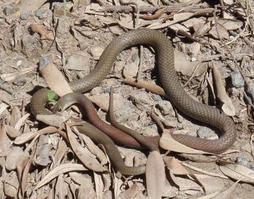 Eastern Brown Snake
Cresent Head NSW
© Photo by ‘Bev’
http://habitatnetwork.org/PhotoPages/Member-and-AnimalPhotos.htm#E
. Eastern Brown Snake
Cresent Head NSW
© Photo by ‘Bev’
http://habitatnetwork.org/PhotoPages/Member-and-AnimalPhotos.htm#E
.
References:
.
[1] Blue Mountains Gazette, p.11, ‘ Snake Bludgeoned at Blackheath‘, by Krystyna Pollard, http://www.bluemountainsgazette.com.au/news/local/news/general/snake-bludgeoned-at-blackheath/2064355.aspx
[2] Snake Handler.com.au, http://www.snakehandler.com.au/?pid=main&p=30
[3] HabitatNetwork.org http://habitatnetwork.org/PhotoPages/Member-and-AnimalPhotos.htm#E
[3] National Parks and Wildlife Act 1974, Specific Penalties and Orders, Judicial Commission of NSW, http://www.judcom.nsw.gov.au/publications/benchbks/local/National_Parks_and_Wildlife_Act.html
[4] CRIMES (SENTENCING PROCEDURE) ACT 1999, Section 17 ‘Penalty Units’, http://www.austlii.edu.au/au/legis/nsw/consol_act/cpa1999278/
.
|
|
 Thick natural bushland habitat just west of Katoomba
Central Blue Mountains Region.
New South Wales, eastern Australia.
Thick natural bushland habitat just west of Katoomba
Central Blue Mountains Region.
New South Wales, eastern Australia.
 The cypress pine cottage, 2008
.
The cypress pine cottage, 2008
.
 One of the chainsawed native trees
.
One of the chainsawed native trees
. The cottage was sold in 2008…with views
…less the dozen chainsawed Eucalypts to make way for the views.
The cottage was sold in 2008…with views
…less the dozen chainsawed Eucalypts to make way for the views.
 A nearby cottage of remarkably similar cypress pine cladding
has surrounding trees chainsawed and the vegetation slashed to bare earth.
A nearby cottage of remarkably similar cypress pine cladding
has surrounding trees chainsawed and the vegetation slashed to bare earth.
 Click image to open PDF document
Click image to open PDF document
 Blue Mountains escarpment is slashed by the RFS, a kilometre west of the cottage site.
Blue Mountains escarpment is slashed by the RFS, a kilometre west of the cottage site.
 The RFS contractor slashed a trail for over 700m through heathland and through a riparian zone,
even before the Hazard Reduction Certificate was issued.
.
The RFS contractor slashed a trail for over 700m through heathland and through a riparian zone,
even before the Hazard Reduction Certificate was issued.
.
 The ‘hazard’ reduction (HR) burning commences
The ‘hazard’ reduction (HR) burning commences
 The aftermath
Three months on, evidence of more than just ground-cover has been burnt.
Deliberate intense burning has been allowed to penetrate deep into mature Eucalypts
The aftermath
Three months on, evidence of more than just ground-cover has been burnt.
Deliberate intense burning has been allowed to penetrate deep into mature Eucalypts
 The fire was so intense that the flames reached into the tree canopy.
It must have been a blaze and half for RFS fire-lighters.
The fire was so intense that the flames reached into the tree canopy.
It must have been a blaze and half for RFS fire-lighters.
 RFS telltale
.
RFS telltale
.
 The cottage relative to the HR burn (aftermath)
The cottage relative to the HR burn (aftermath)
 Bushland habitat at Bonnie Doon at risk of further burning
Bushland habitat at Bonnie Doon at risk of further burning
 Fire-lighters look on during the Hazard Reduction Burn, Bonnie Doon Reserve
Fire-lighters look on during the Hazard Reduction Burn, Bonnie Doon Reserve More bushland for sale
~ a ‘lose-lose’ outcome for native habitat and the remnant disappearing wildlife is supports.
More bushland for sale
~ a ‘lose-lose’ outcome for native habitat and the remnant disappearing wildlife is supports. Bonnie Doon Reserve
on the western fringe of Katoomba township
Bonnie Doon Reserve
on the western fringe of Katoomba township




































































